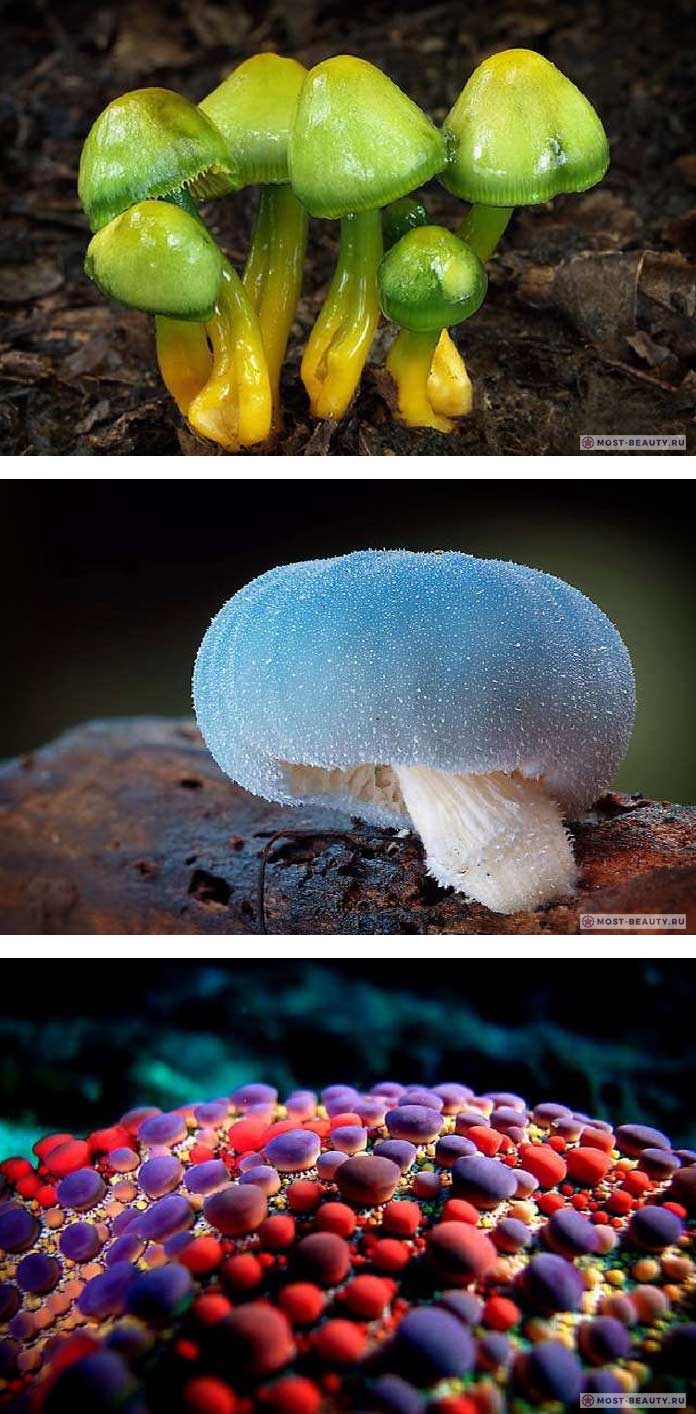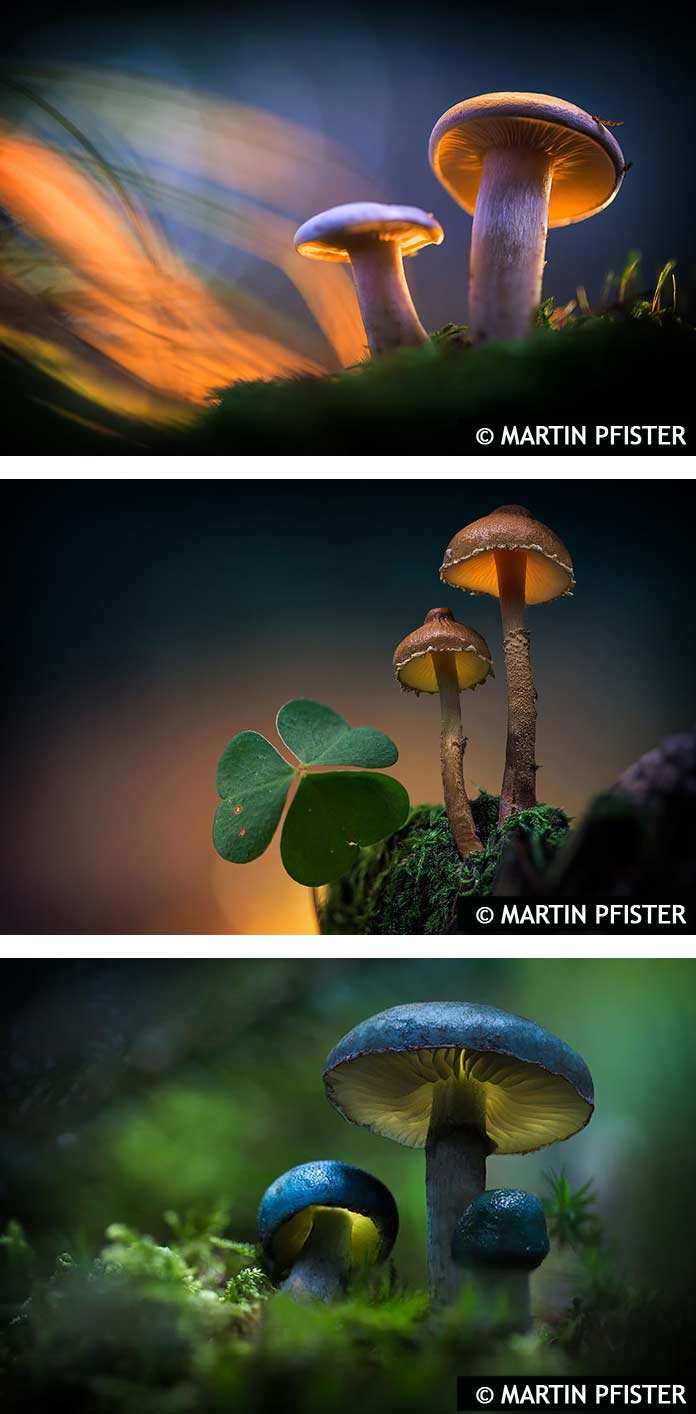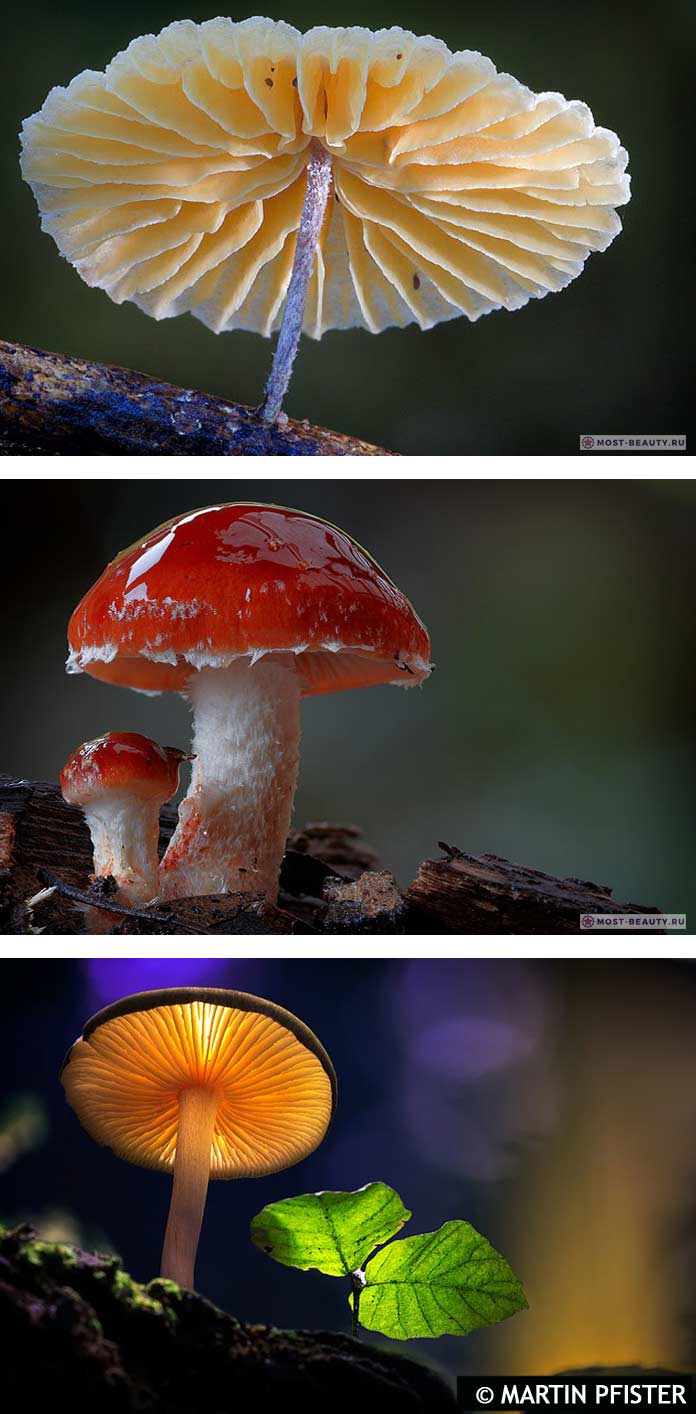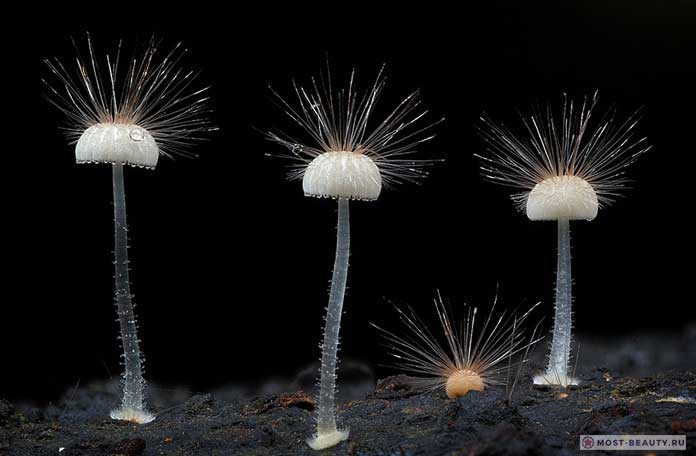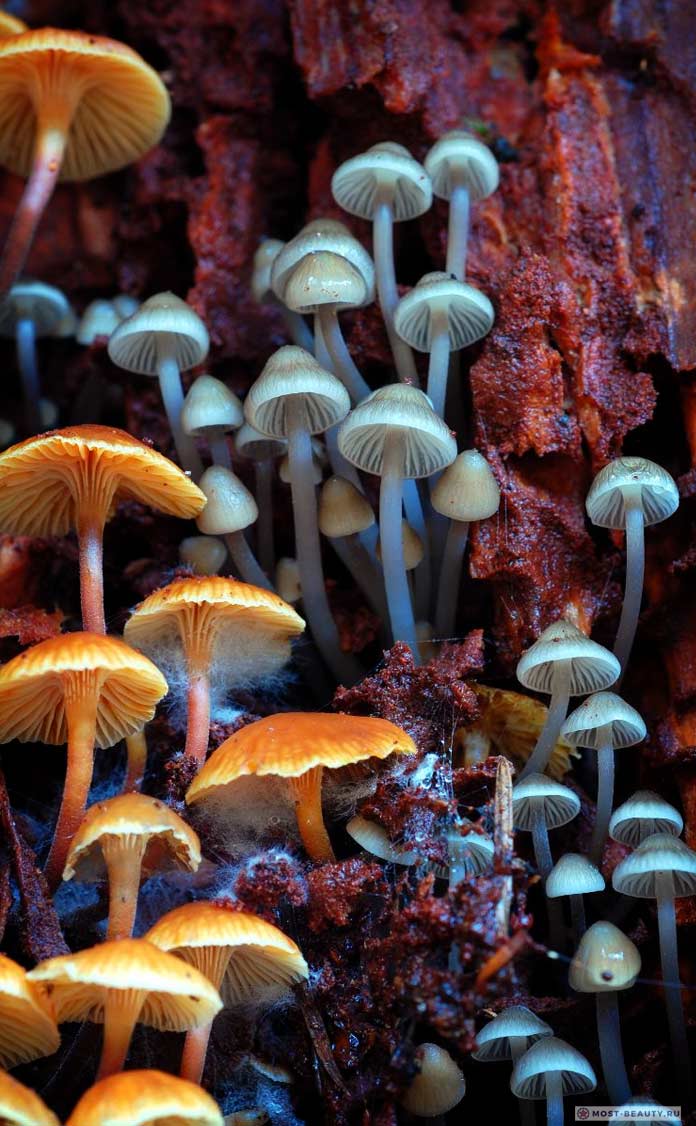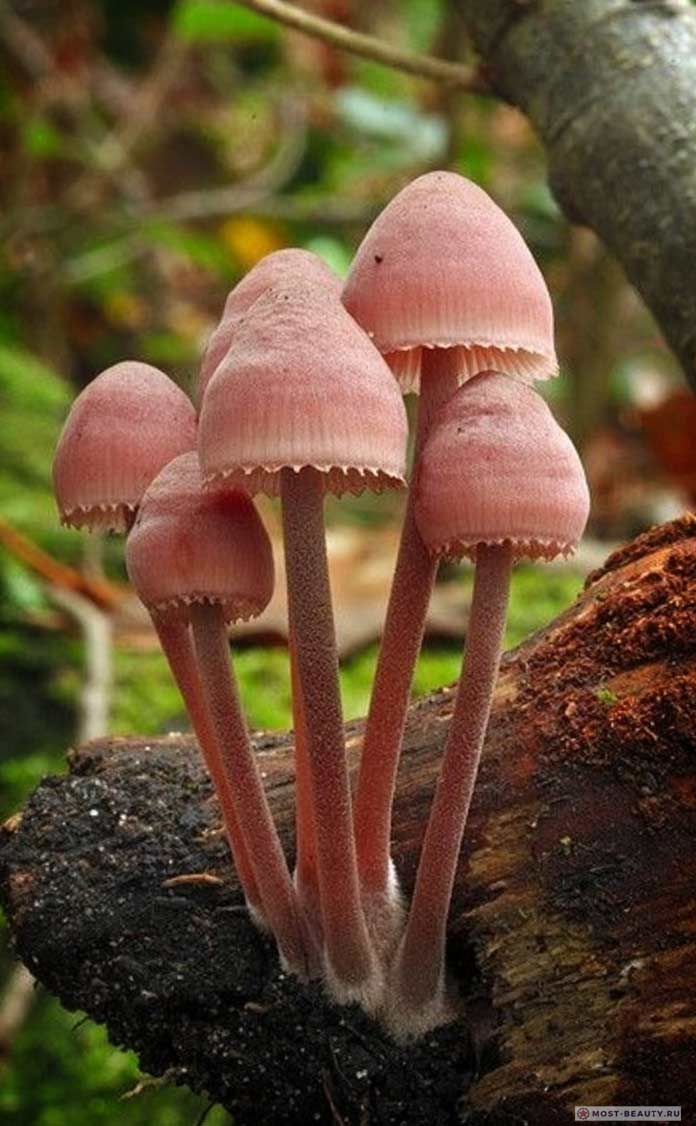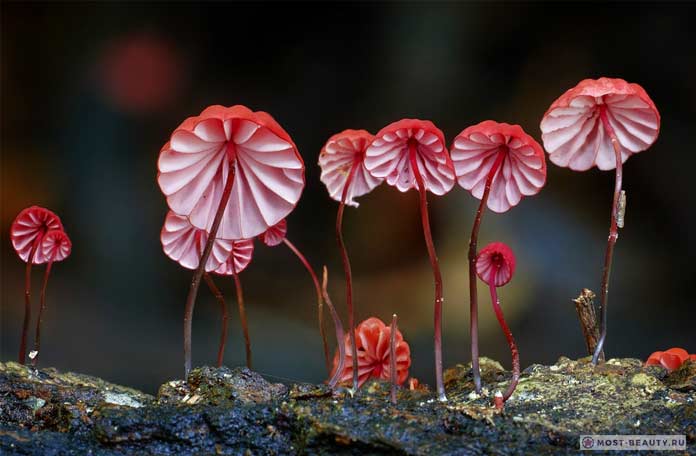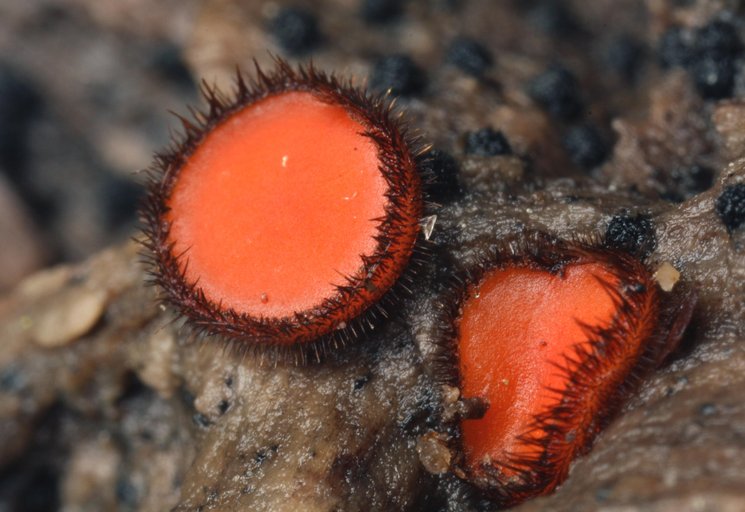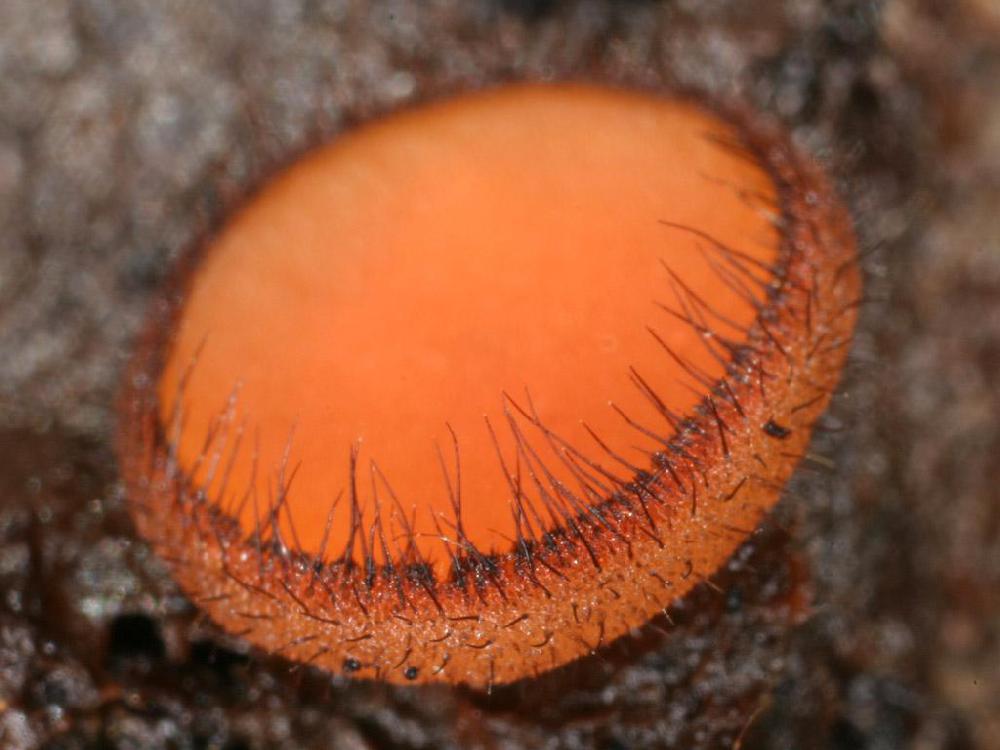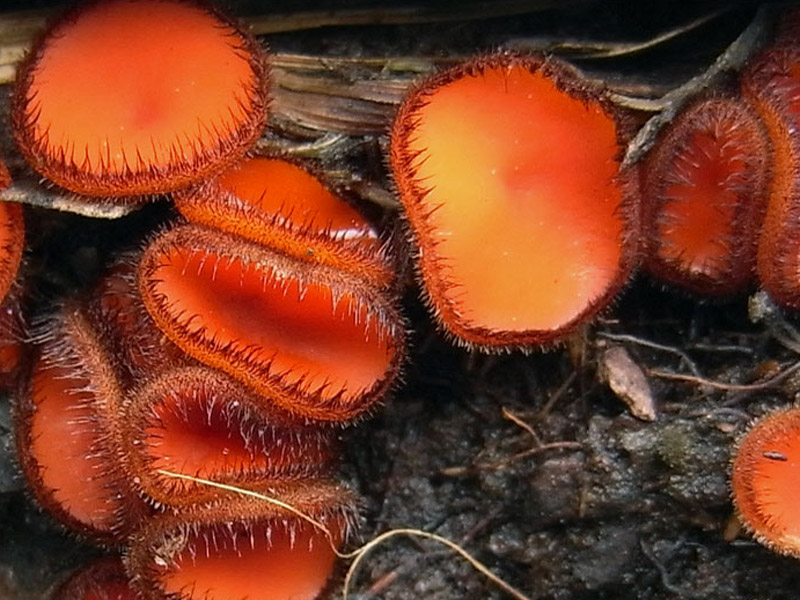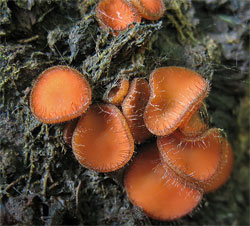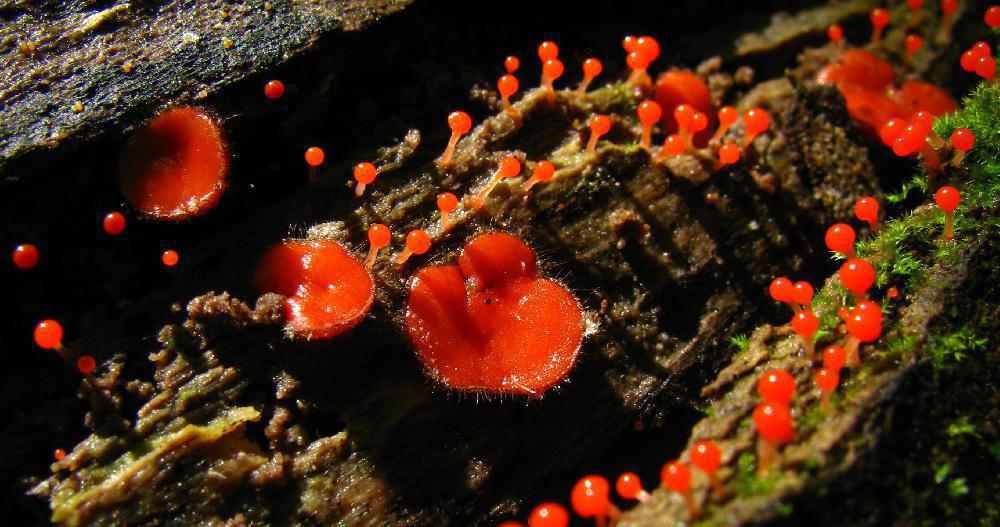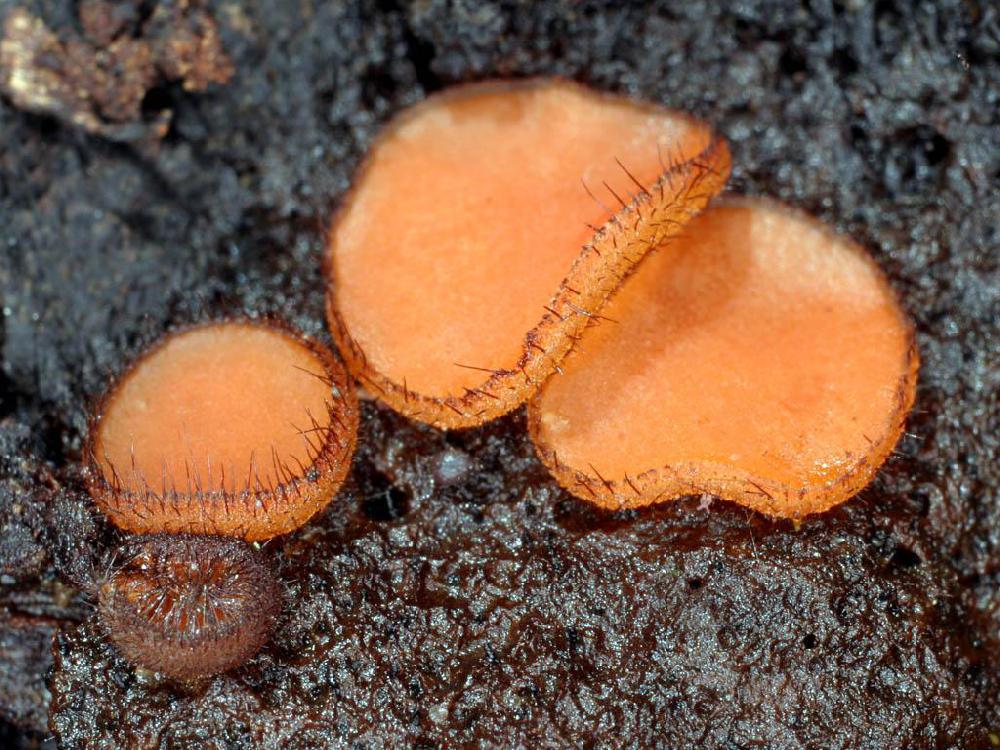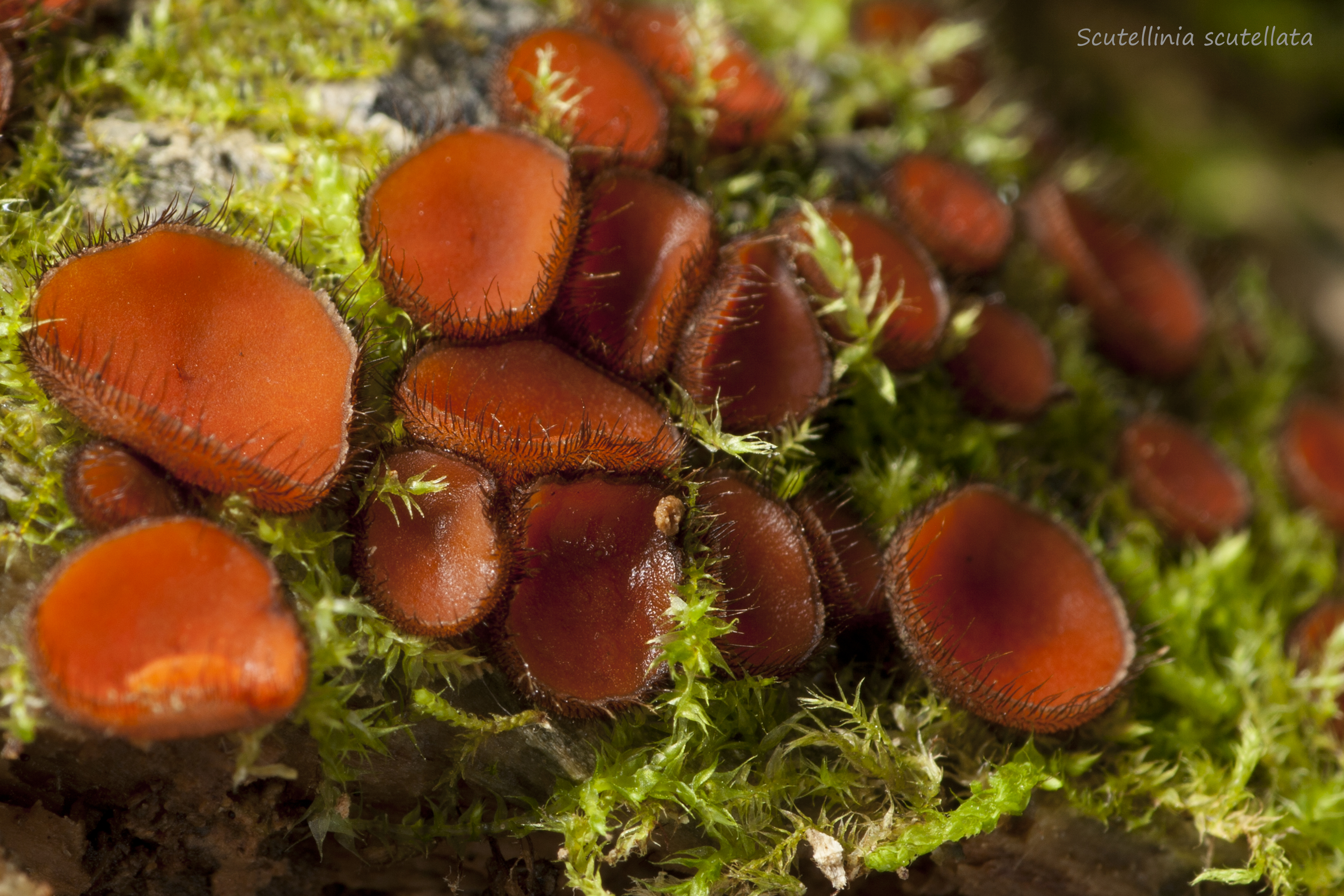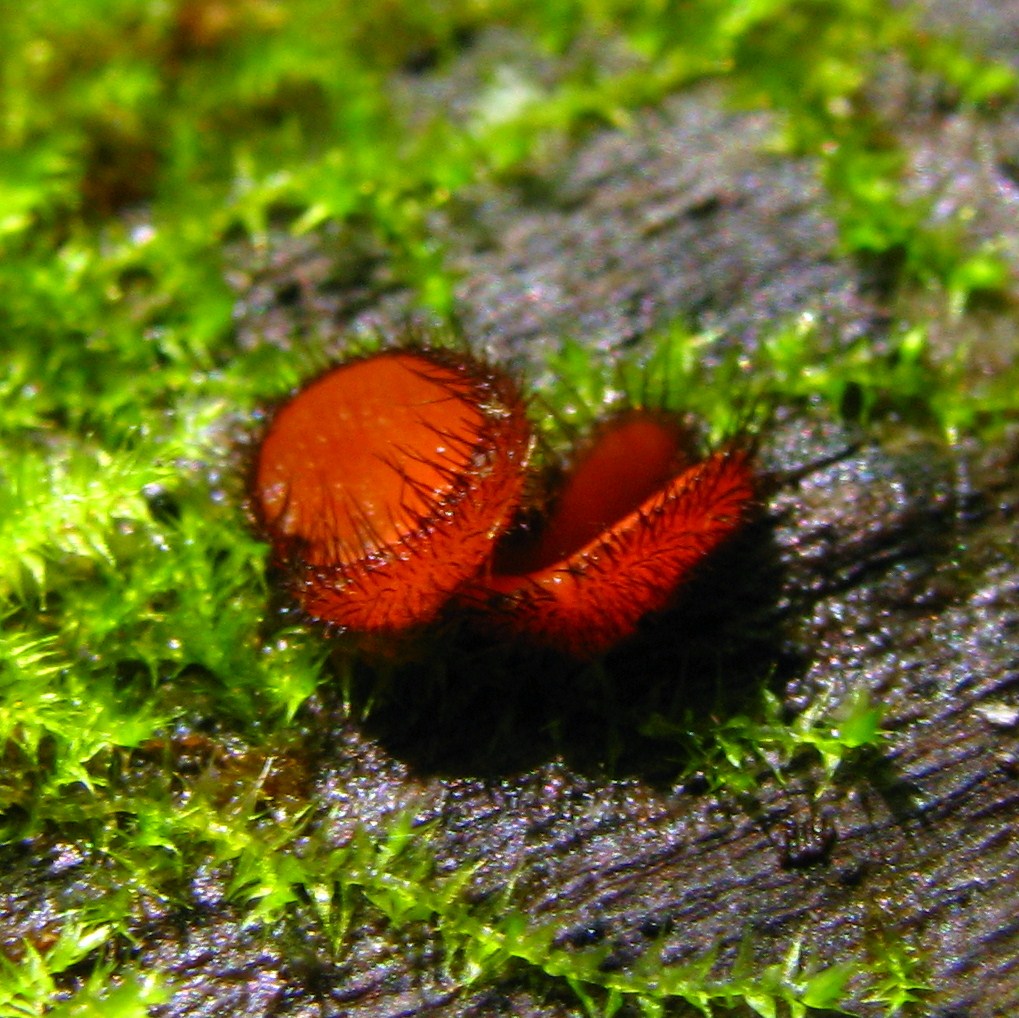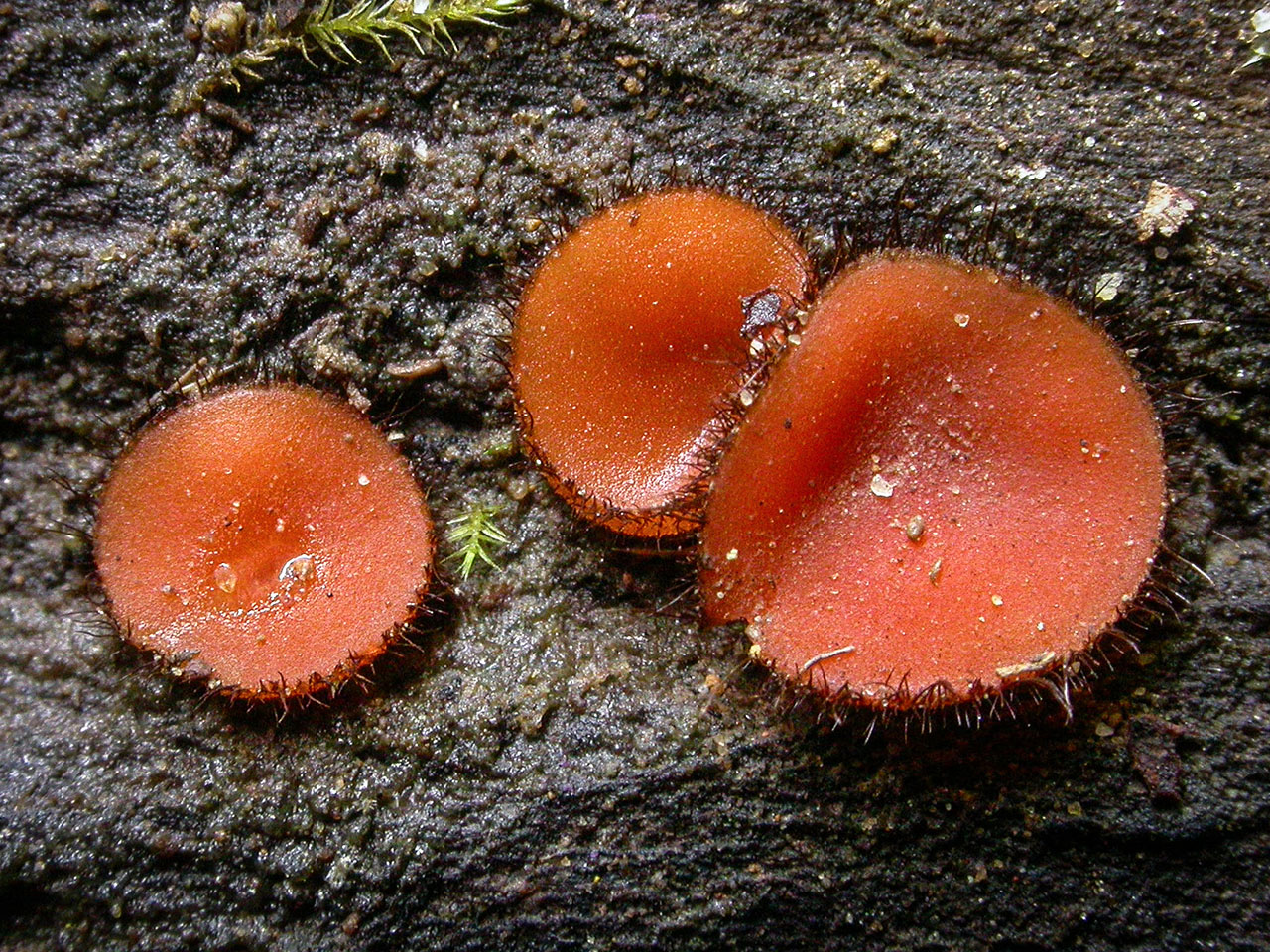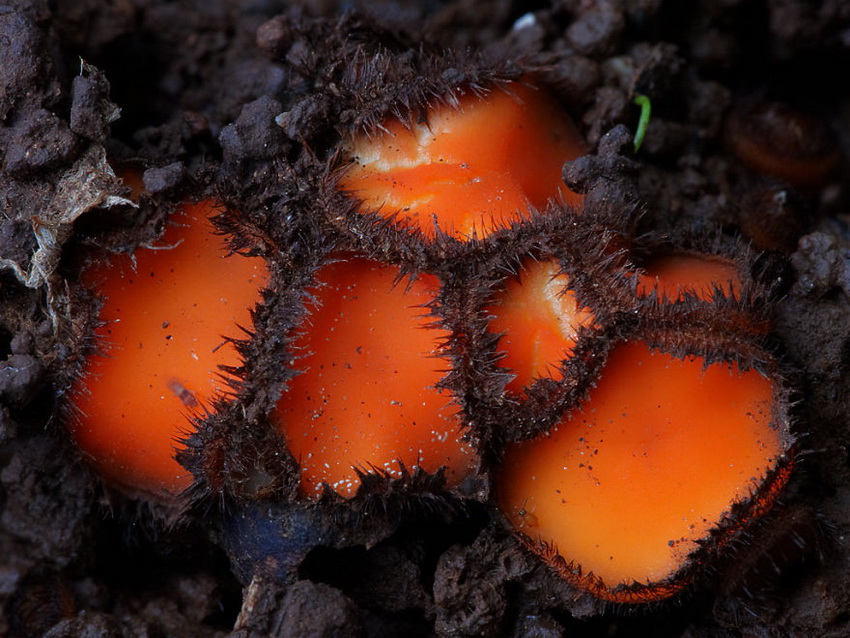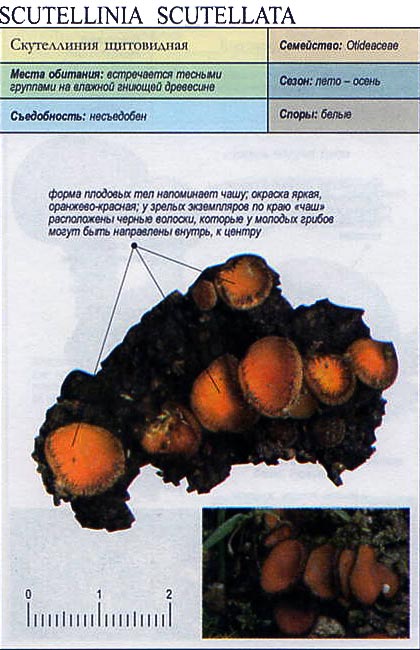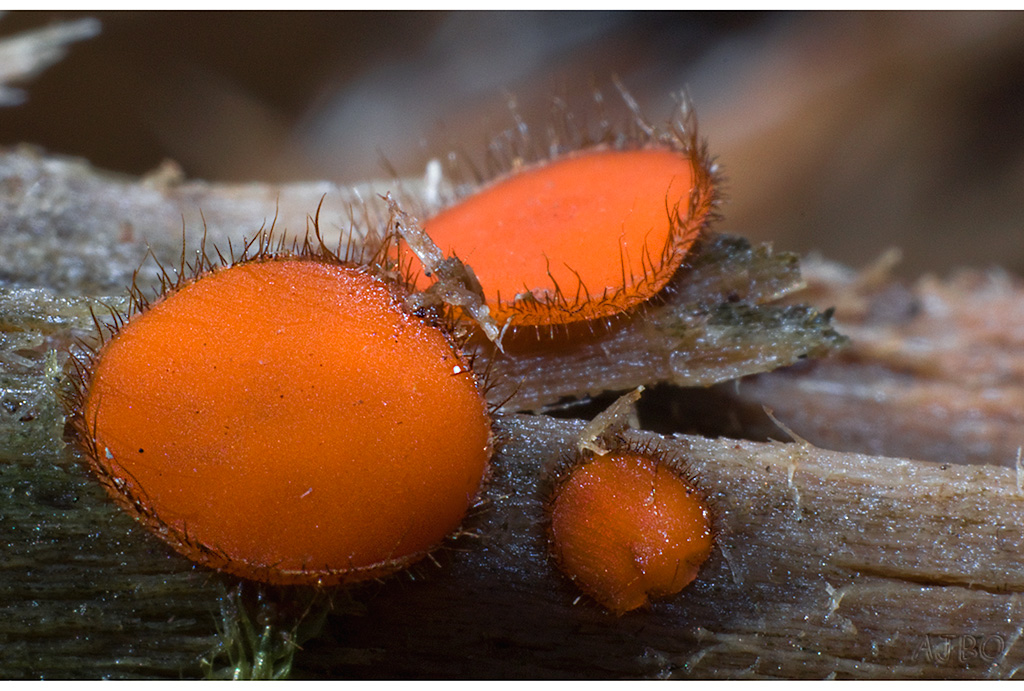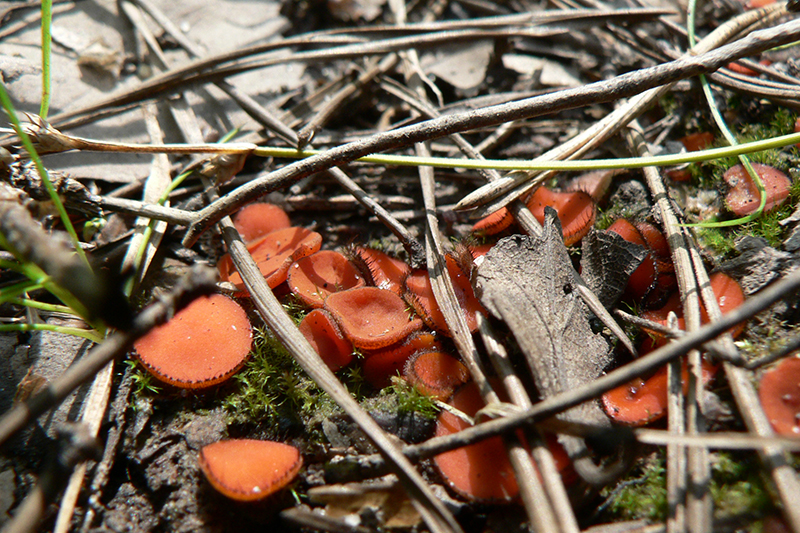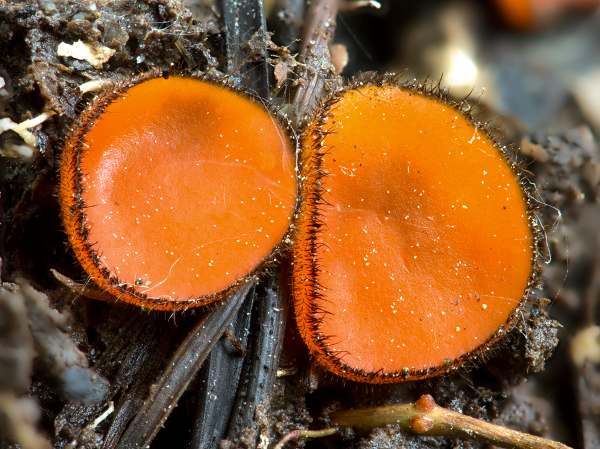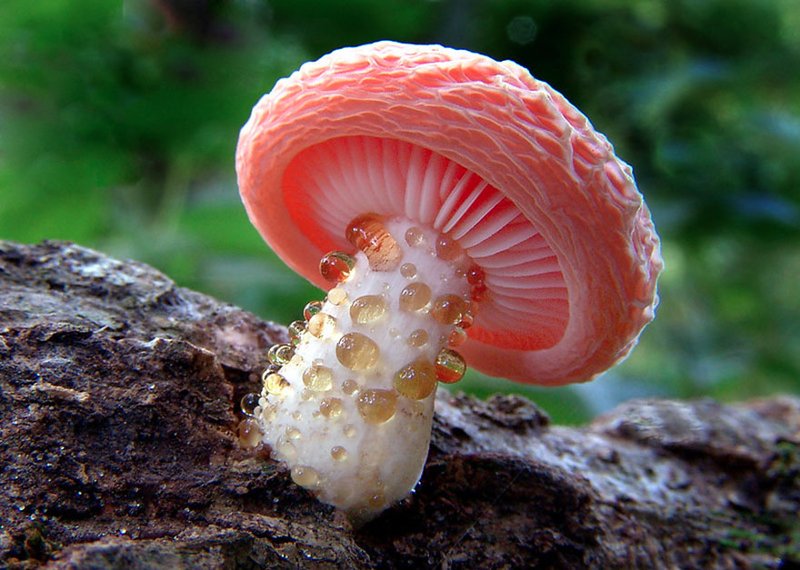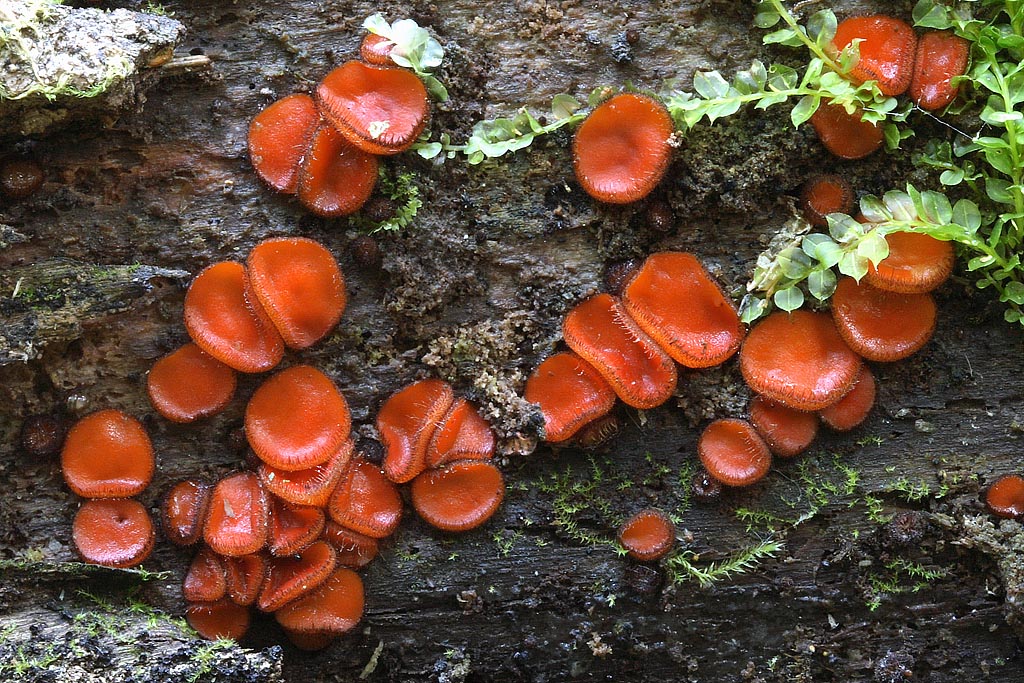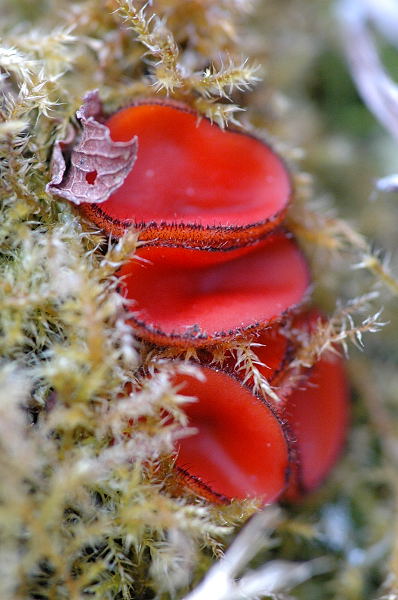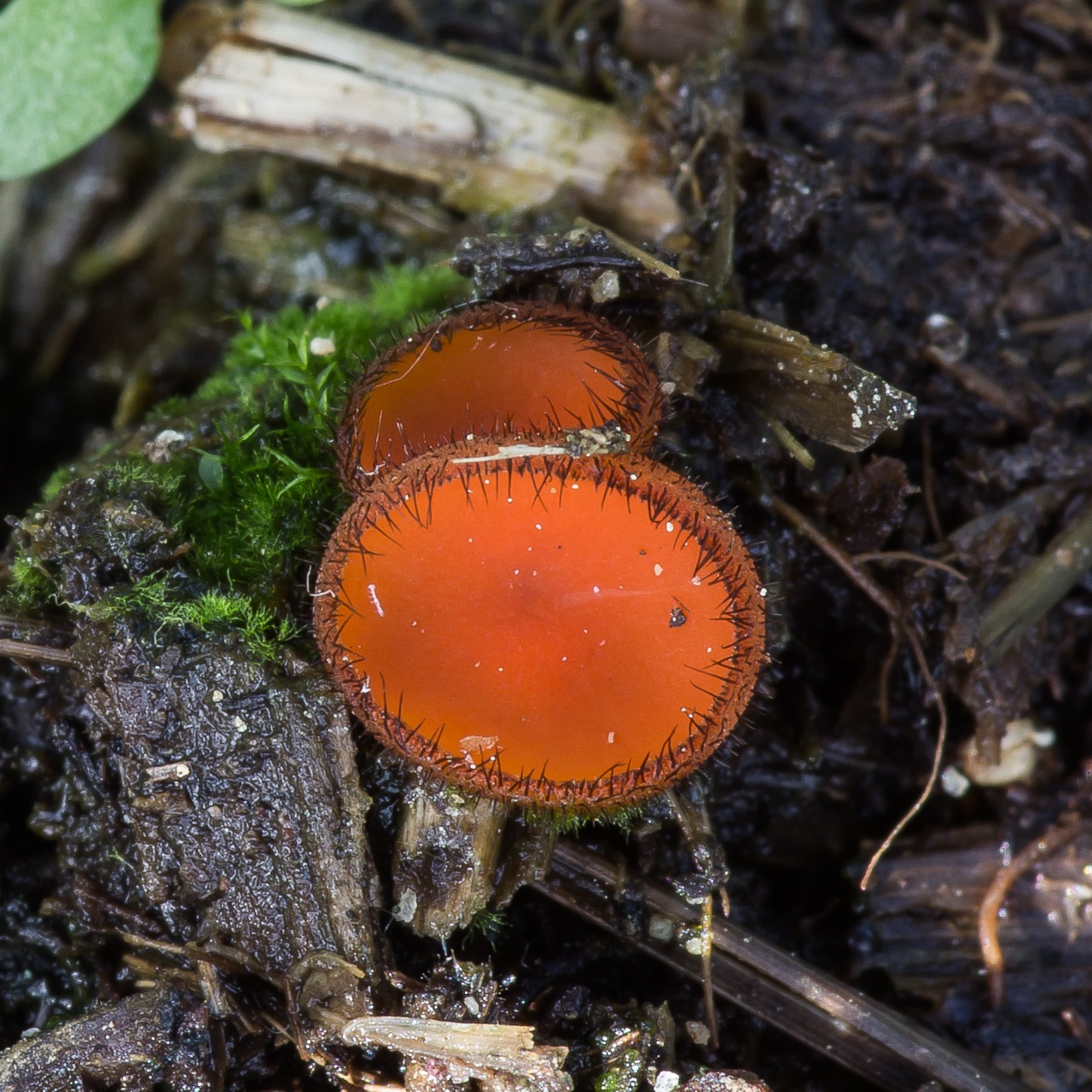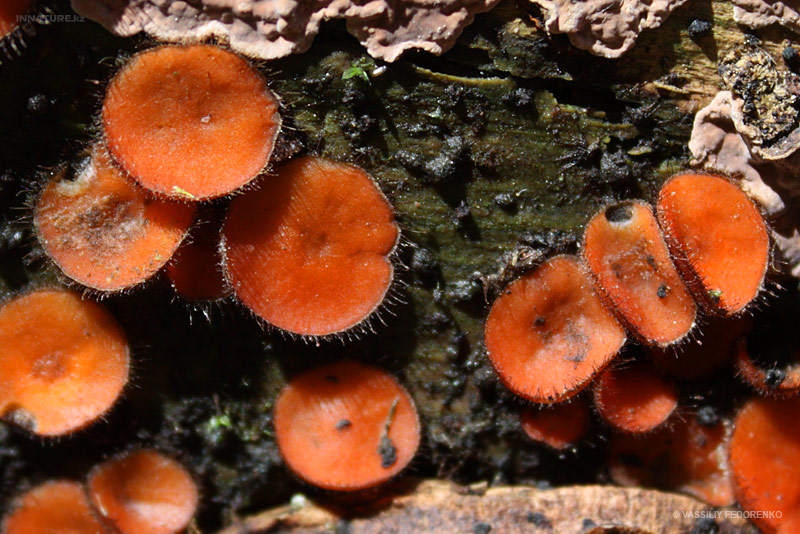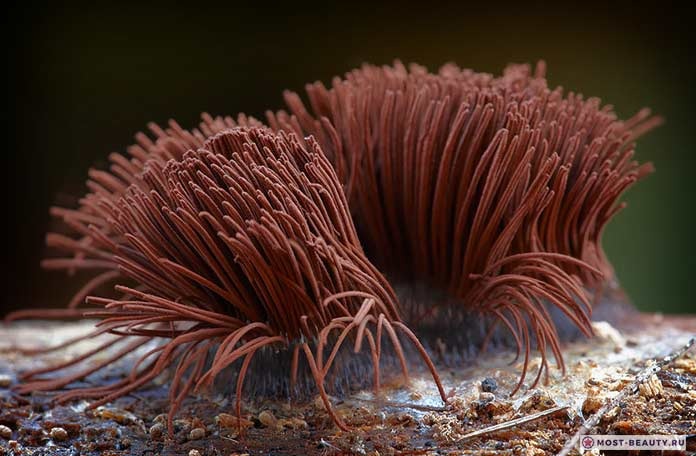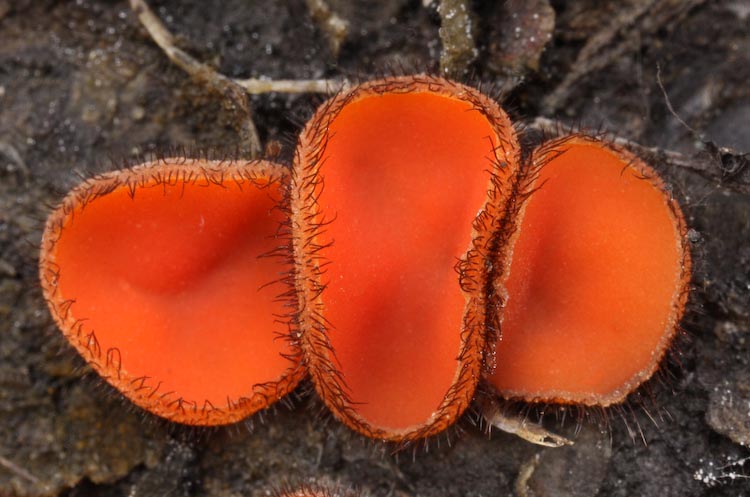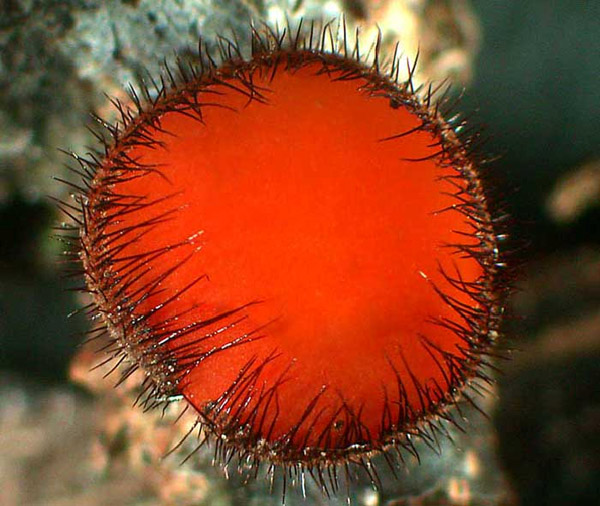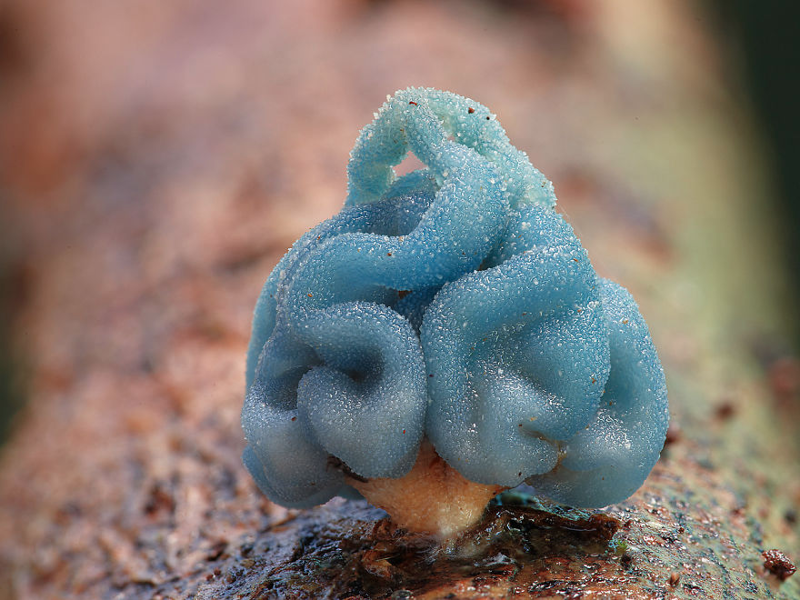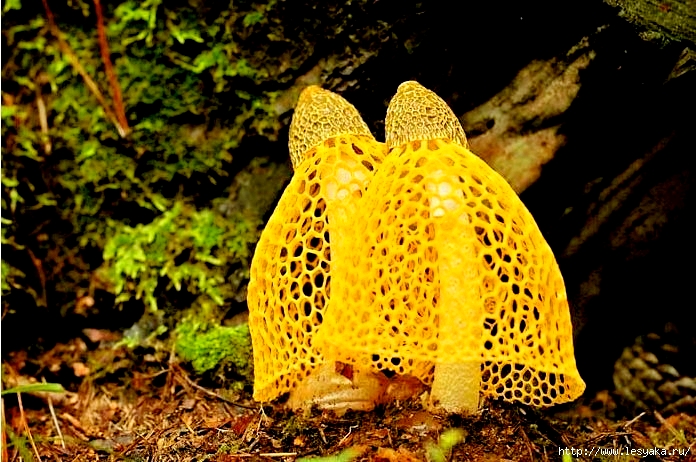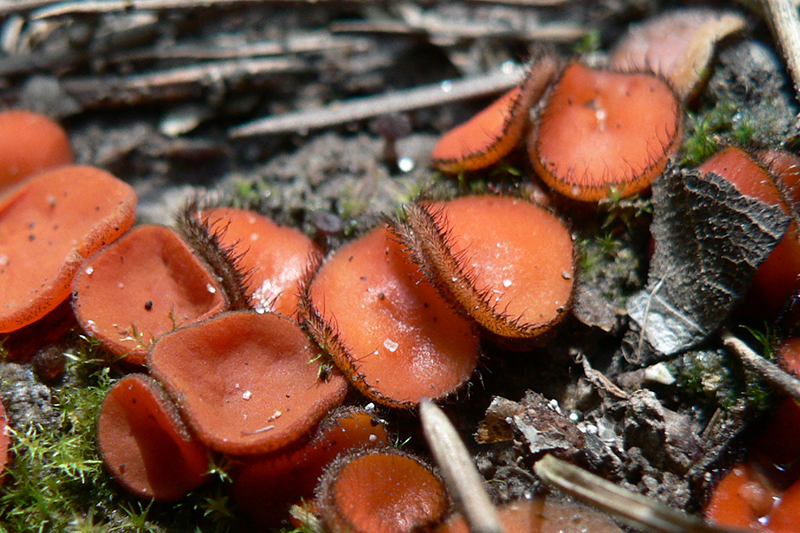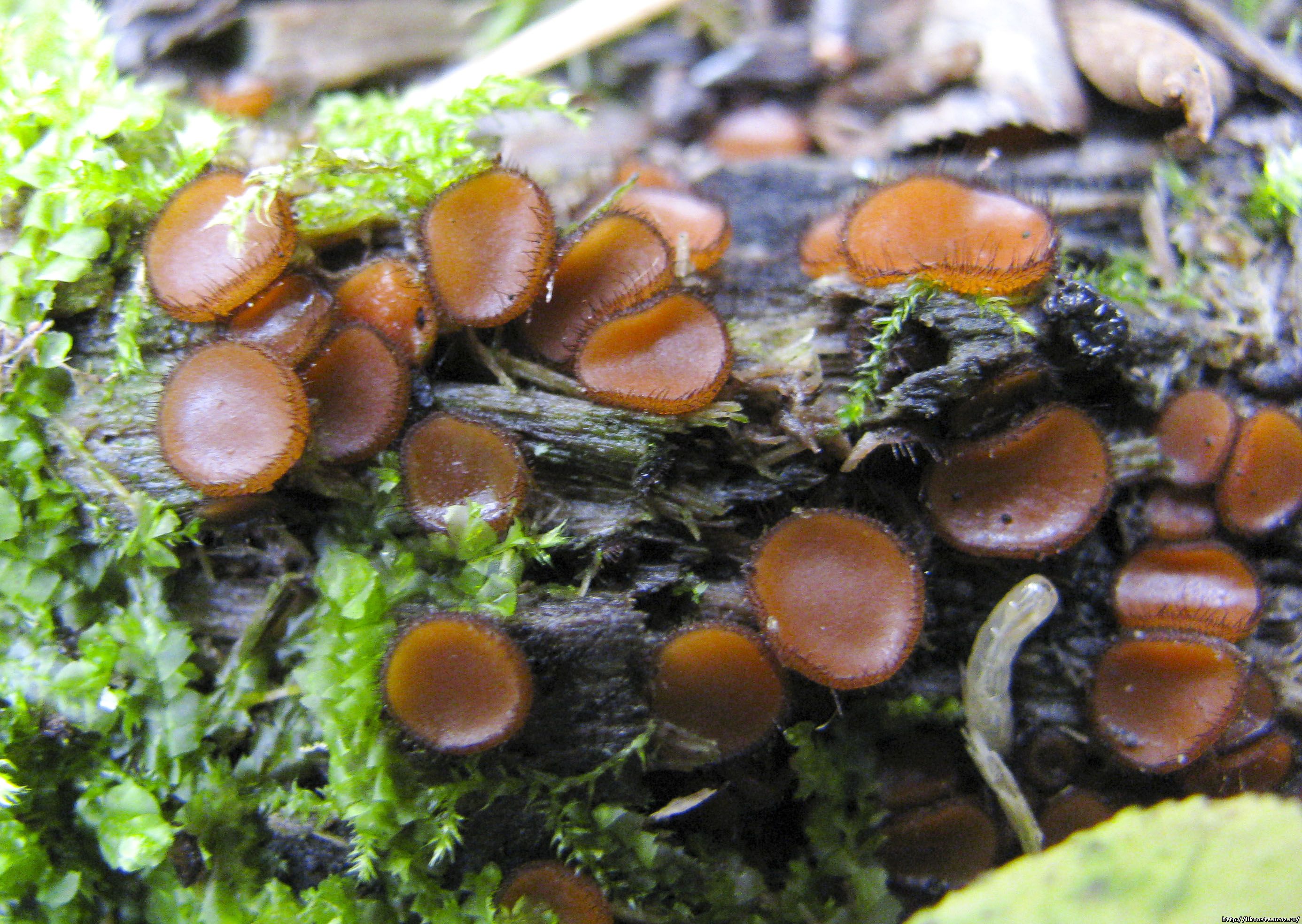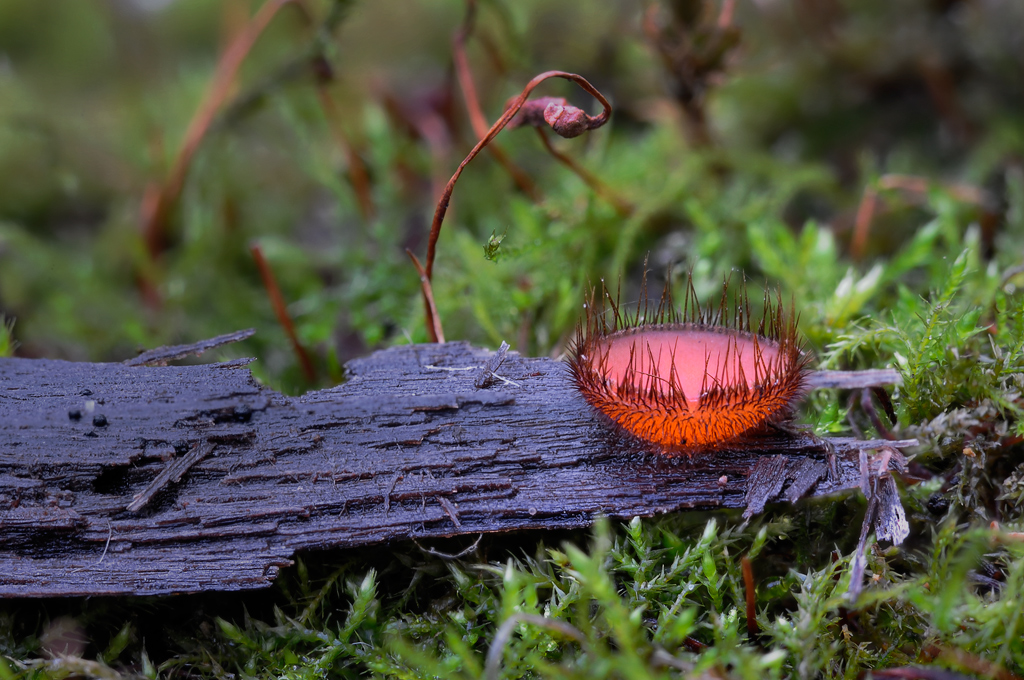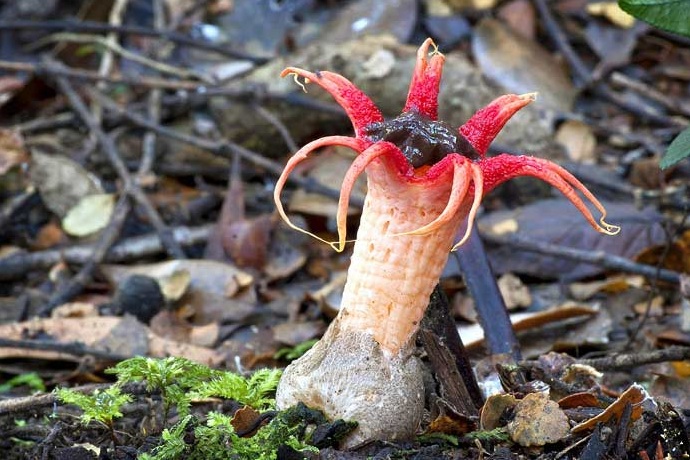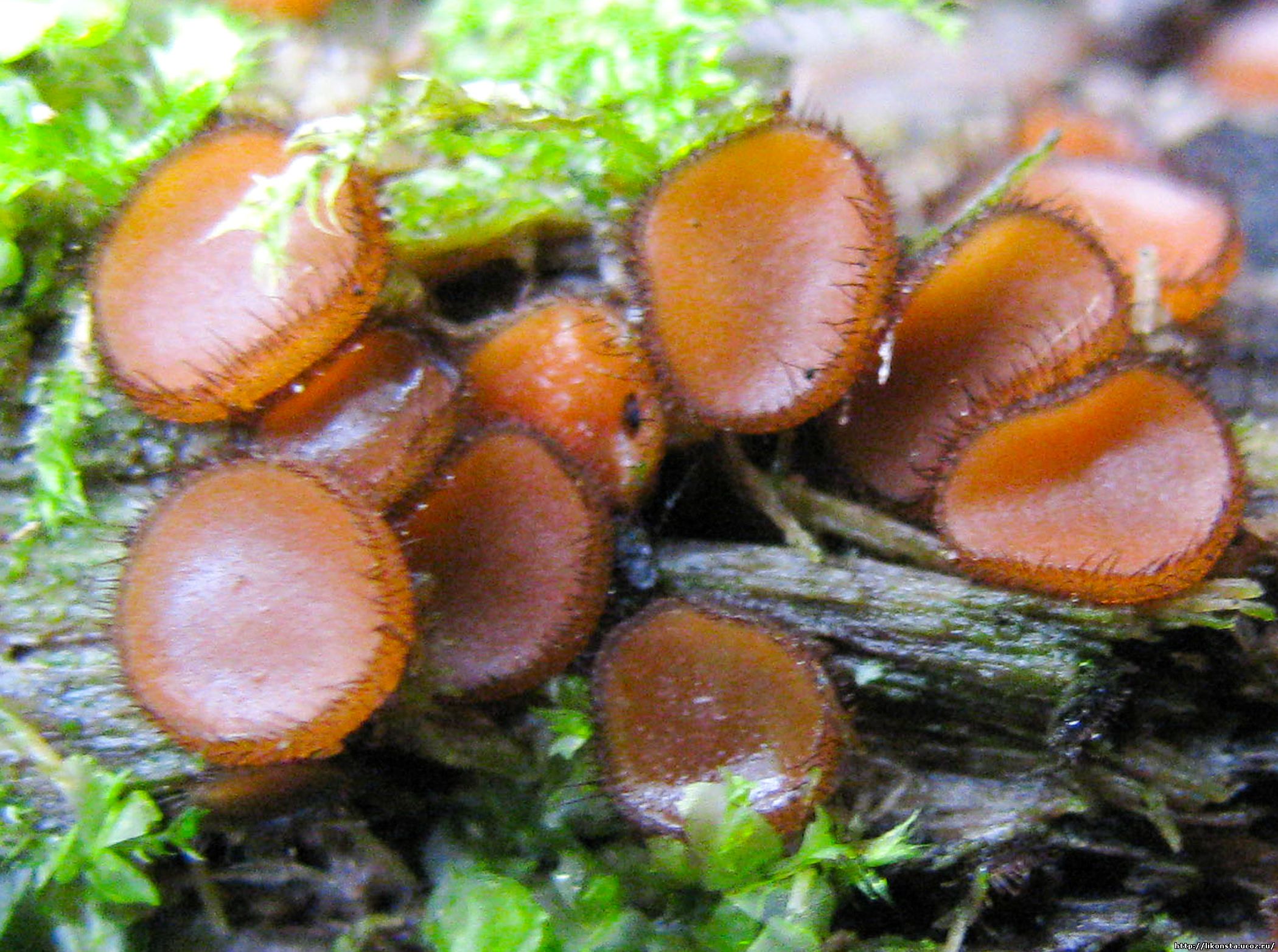The most unusual mushrooms in the world
Even the most avid mushroom pickers can surprise some mushrooms with their unusual appearance. Let's take a look at the most amazing mushrooms in the world.
At the top of this list is the luminescent mushroom (Chlorophos mycena). It would seem that neon mushrooms can only be in science fiction films, but they do exist. Mushrooms with unusual shine are native to Brazil and Japan. In these countries, unusual green mushrooms appear during the rainy season.
The edibility of luminescent mushrooms is unknown, this is due to the fact that few people dare to taste the luminous dish. They grow at the base of tree trunks, next to broken branches, on foliage and simply on damp soil. At night, you can enjoy the most beautiful lighting created by nature itself.
Bioluminescence is the incredible ability of living organisms to emit radiance. This phenomenon is associated with the chemical processes of the body and the release of energy released in the form of light. The ability to shine is observed not only in mushrooms, but also, for example, in fireflies and some types of jellyfish.
Unusual blue mushroom
Another unusual representative of the mushroom kingdom is the blue mushroom (Entoloma hochstetteri). These mushrooms are common in New Zealand and India. Its color is azure, but the spores are reddish. The color of the fungus is given by the pigment azulin, which is also found in some marine invertebrates. Although they are very beautiful mushrooms, you should not try them, they are not edible, however, their toxicity is poorly understood.
The Hydnellum Peck mushroom, which is also called a bleeding tooth, and its Latin name is Hydnellum peckii, looks very unusual. It is unlikely that anyone will want to taste this strange mass.
And it's worth noting that the taste of the pulp is incredibly bitter. Hydnellum Peka is more common than blue and luminous mushrooms. They grow in North America, Europe, Korea and Iran. They settle in coniferous forests, and bear fruit in the fall.
Another amazing mushroom is Nidulariaceae. Bird nest mushrooms grow in New Zealand. The mushroom has an original shape, which is why it got its name. This form of fruiting bodies serves for the spread of spores.
In spore eggs, rainwater accumulates, when they are completely filled, they burst, and the spores fly up to a distance of 1 meter.
The official name of this mushroom is Chorioactis geaster. The devil's cigar is considered one of the rarest mushrooms on earth. Due to the fact that this mushroom is found in Texas, it is also called the Star of Texas. However, the devil's cigars grow in two other areas of Japan.
While the spores of the fungus are inside the fruiting body, it looks like a brown capsule, which really looks like a cigar. When the mushroom opens up and releases the spores, it resembles a star or a cactus flower.
The devil's cigar, when throwing out spores, emits a whistling sound, it is the only mushroom in the world that can "talk". Maybe because of this, he got such an ominous name.
The name of this mushroom is unattractive; in addition, it has a rather indecent appearance. The Latin name for the mushroom is Mutinus caninus, which means "like a dog."
A mushroom with such an unattractive name is edible, but only at a young age, while it is in an ovoid shell and has a less defiant appearance. These mushrooms are listed in the Red Book. They bear fruit from July to October.
Canine mutinuses grow in the Stavropol Territory, Tomsk and Leningrad Regions, Krasnodar and Primorsky Territories, Karelia, Georgia, Armenia, Lithuania, Estonia and North America. These mushrooms settle on sawdust, rotten wood and stumps.
This mushroom is native to Australia. The scientific name of the mushroom is Aseroe rubra. This unusual mushroom belongs to those species that do not look like mushrooms at all. It looks more like some kind of outlandish tropical flower, for example, a staple or rafflesia. In addition to the fact that the sea mushroom looks similar to these flowers, it also uses the services of flies.Flies carry fungal spores. The sea mushroom, rafflesia, and stapelia all give off an unpleasant smell of musty meat that flies like very much.
Amanita muscaria / Amanita muscaria
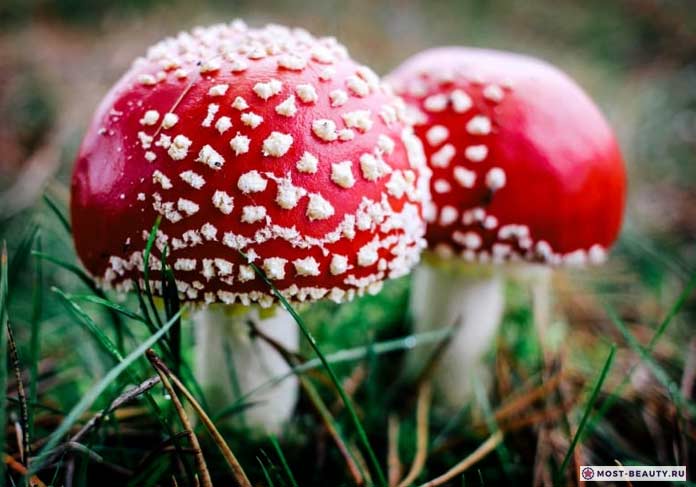
Everyone knows from childhood that the fly agaric is poisonous, but in the vastness of Russia it is perhaps the most beautiful mushroom that attracts attention with its amazing appearance. It is very easy to distinguish it from other types of mushrooms.
A red cap with white spots rises high above the earth's surface on the same snow-white leg. Eating fly agaric has an intoxicating effect, and in the old days it was used by the shamans of Siberia to induce hallucinations, or, as in the jargon of drug addicts, galyuni. But still, this species is considered inedible.
It is very easy to distinguish it from other types of mushrooms. A red cap with white spots rises high above the earth's surface on the same snow-white leg. Eating fly agaric has an intoxicating effect, and in the old days it was used by the shamans of Siberia to induce hallucinations, or, as in the jargon of drug addicts, galyuni. Still, this species is considered inedible.
The etymology of the name from the word "fly" is also interesting, since in Europe it was widely used to protect homes from these harmful insects.
22
Scutellinia scutellata
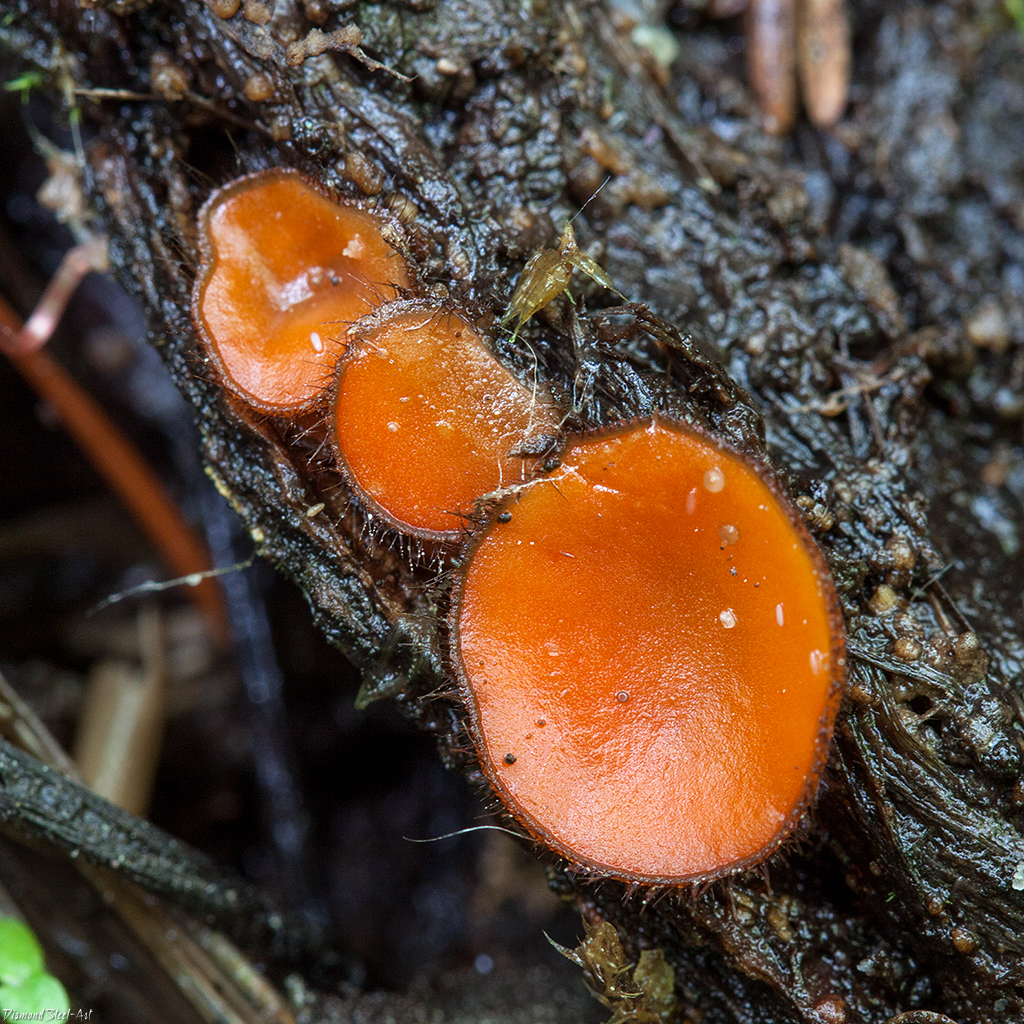
Current title
| Index Fungorum | Scutellinia scutellata (L.) Lambotte | |
| MycoBank | Scutellinia scutellata (Linnaeus) Lambotte |
Systematic position
Habit
Fruit body: Cup-shaped, saucer-shaped, in the form of ears (discomycetes)
Hymenophore: Smooth, not pronounced
Fruiting body
Apothecia are 5-10 mm in diameter, at first almost closed, hemispherical, then saucer-shaped, bright red, orange, yellow-orange.
Outside and along the margin, long, stiff, dark brown setae, like cilia, 0.2-1.5 mm in length.
Microscopy
Spores are broadly elliptical, smooth, with small punctures - warts, with a large number of small oil droplets inside, 19 - 21 × 13 - 13.5 µm.
The bags are eight-spore, 253 - 266 × 18 - 20 microns.
Paraphysis with clavate thickening (up to 10 microns) at the ends.
Hairs 1000 (2000) × 45 μm, dark brown, thick-walled, with several thin septa, pointed.
Ecology and distribution
- Substance: Woody plants (living trees, bark and dead wood)
- Substrate: Soil, litter
On decaying wood, on the soil - at the base of stumps, loves wet, swampy places.
Fruiting
The divisions correspond to the decades of the month.
Nutritional properties
Related materials
- Breitenbach J, Kränzlin F. - Fungi of Switzerland A Contribution to the Knowledge of the Fungal Flora of Switzerland. Vol 1. Ascomycetes (1984)
- Garibova L. V., Sidorova I. I. - Mushrooms. Encyclopedia of Nature of Russia (1997)
- Prokhorov V.P., Teplova L.P. - Spring and autumn discomycetes (school guide) (1982)
Link to this page for prints
Ageev D.V., Bulonkova T.M.
Share link
Discussions

| 2537 | |
| Dmitry Ageev | |
| 2013-07-03T10: 43: 59 | |
| Last modified date: | 2018-11-15T11: 36: 04 (Dmitry Ageev) |
OOO OOO OOO OOO OOO OOO OOO OOO OOO OOO OOO OOO OOO OOO OOO OOO OOO OOO OOO OOO OOO OOO OOO OOO OOO OOO OOO OOO OOO OOO OOO OOO OOO OOO OOO OOO OOO OOO OOO OOO OOO OOO OOO OOO OOO OOO OOO OOO OOO OOO OOO OOO OOO OOO OOO OOO OOO OOO OOO OOO OOO OOO OOO OOO OOO OOO OOO OOO OOO OOO OOO OOO OOO OOO OOO OOO OOO OOO OOO OOO OOO OOO OOO OOO OOO OOO OOO OOO OOO OOO OOO OOO OOO OOO OOO OOO OOO OOO OOO OOO OOO OOO OOO OOO OOO OOO OOO OOO OOO OOO OOO OOO OOO OOO OOO OOO OOO OOO OOOì
Age restrictions
Federal Law of the Russian Federation of December 29, 2010 No. 436-FZ "On the Protection of Children from Information Harmful to Their Health and Development."
Control
2010–2019 All rights reserved.
Definitioner
Multicellular or unicellular non-spore-bearing outgrowths in some algae, fungi and mosses, which protect the genitals or spore-bearing organs from drying out and mechanical damage.
In the type, a completely open ascocarp, often saucer-shaped or goblet-shaped. On the surface of the apothecia there is an ordered hymenial layer, consisting of bags and sterile elements - the paraphysis, under it lies the subhymenal layer, in which the asci develop, and everything else is made up of sterile hyphae of the pulp - the excipule. Apothecia is characterized by the simultaneous maturation of many asci and the active release of spores. Secondary closed apothecia are found in fungi, whose fruiting bodies develop underground, for example, in truffles.
See Ascocarp, Hymenium, Discomycetes, Paraphysis.
A specialized cell of marsupial fungi (ascomycetes), inside which ascospores develop as a result of the sexual process.
The structure of the bursae is an important diagnostic feature used in the ascomycete system. There are prototunicate and eutunicate asci.The first ones have a thin shell, not divided into layers, which spreads out during the maturation of ascospores, and they are released passively. The latter have a denser, layered membrane, equipped with a specialized apical apparatus for opening, and ascospores are actively discarded.
Among eutunicate asci there are uniticate ones, the layers of the shell which grow together and open simultaneously, and bitunicate ones, whose shell consists of two sequentially opening layers. A further subdivision of uniticate bags is based on the structure of the apical apparatus.
Scutellinia thyroid (Scutellinia saucer): photo and description
| Name: | Scutellinia thyroid |
| Latin name: | Scutellinia scutellata |
| Type of: | Inedible |
| Systematics: |
|
Thyroid scutellin (Latin Scutellínia scutellata) or saucer is a small mushroom with a rather unusual shape and bright color. It does not belong to the number of poisonous varieties, however, its nutritional value is low, which is why the species is not of particular interest to mushroom pickers.
What does scutellinia thyroid look like?
In young specimens, the fruiting body is spherical. As it matures, the cap opens and takes on a cupped shape, and then completely becomes almost flat. Its surface is smooth, painted in a rich orange color, which sometimes turns into light brown tones. A distinctive feature of the species are stiff bristles that run in a thin line along the edge of the cap.
The pulp is quite brittle, inexpressive in taste. Its color is reddish orange.
There is no pronounced leg - it is a sedentary variety.
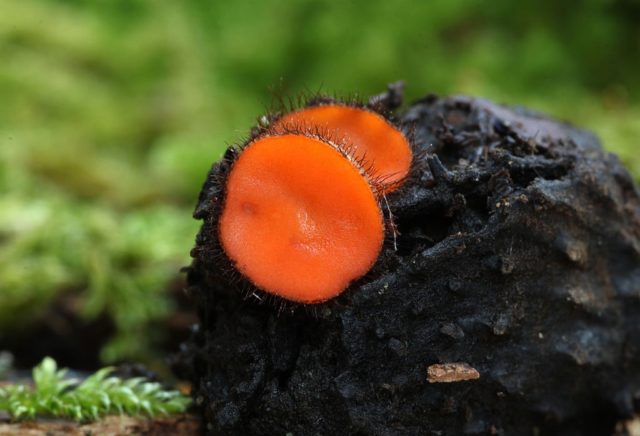
Where and how it grows
Preferred growth sites are dead wood, which means rotten stumps, fallen and decaying trunks, etc. Mushrooms rarely grow alone, most often small dense groups can be found.
Is the mushroom edible or not
Scutellinia thyroid is not an edible variety due to its small size. Its nutritional value is also low.
Doubles and their differences
Orange aleuria (Latin Aleuria aurantia) is the most common twin of this species. In the common people, the mushroom is also called orange petsitsa or pink-red saucer. It is represented by a fairly compact fruiting body in the form of a bowl or saucer, the size of which does not exceed 4 cm in diameter. Sometimes the cap looks like an auricle.
A distinctive feature of a double is the presence of curled edges. In addition, there are no rigid bristles at the ends.
They also grow in different places. While scutellinia thyroid settles on dead trees, orange aleuria prefers forest edges, lawns, roadsides and forest paths. The twin bears fruit from July to September.
Despite the fact that orange aleuria is edible (conditionally edible), it is not popular. This is explained by the low value of the species and insignificant size, as is the case with many representatives of this family.
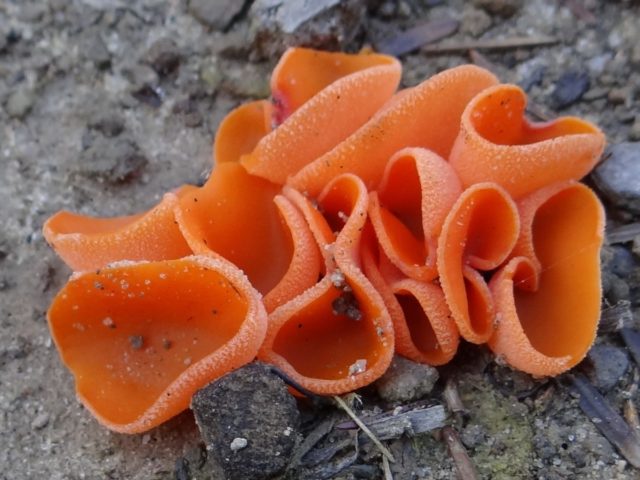
Conclusion
Scutellinia thyroid is a small mushroom that is not of particular interest from a culinary point of view. Its taste is inexpressive, as is the smell, and the size of the fruit bodies is too small.
For more information on how thyroid scutellin looks like, see the video below:
Scutellinia thyroid (Scutellinia saucer, Scutellinia scutellata): how it looks, where and how it grows, edible or not
It occurs singly or, more often, in groups, on wet soil or rotten stumps, logs or branches. Saprotroph.
Similar species
Scutellinia erinaceus (Schwein.) Kuntze 1891 is distinguished by a dark or yellow-orange inner surface of fruit bodies and smooth spores.
Literature
William C. RoodyMushrooms of West Virginia and the Central Appalachians. - The University Press of Kentucky. - P. 471. - 520 p. - ISBN 0-8131-9039-8
Wikimedia Foundation. 2010.
See what "Scutellinia thyroid" is in other dictionaries:
Skugellinia thyroid - Scuteffinia scuteflata (Fr.) Lambotte see also Genus scugellinia Scuteffinia (Cke.) Lambotte em. Le Gal Thyroid Skugellina S. scuteflata (Fr.) Lambotte Apothecia in groups, crowded, 0.2 to 1.2 cm in diameter, saucer-shaped, later flat, with ... ... Mushrooms of Russia. Directory
Geopixis coal - Geopyxis carbonaria (Fr.) Sacc see also Genus geopixis Geopyxis (Fr.) Sacc. Geopixis coal G. carbonaria (Fr.) Sacc. Apothecia 0.5 to 5 cm in diameter, found in groups, often crowded, first globular goblet, later goblet ... Mushrooms of Russia. Directory
Gumaria hemispherical - Humana hemisphaerica (Fr.) Fuck, see also Genus Humana Fuck. Gumaria hemispherical N. hemisphaerica (Fr.) Fuck, Apothecia 0.5 to 2 cm in diameter, retain a hemispherical shape for a long time, later cupped or saucer-shaped, sessile, with ... ... Mushrooms of Russia. Directory
Otidea donkey, donkey ears - Ot> Mushrooms of Russia. Directory
Otidea hare - Ot> Mushrooms of Russia. Directory
Hydnotria Tyulyan - Hydnotrya tnlasnei Berk. et Br see also Genus Hydnotria Hydnotrya Berk. et Br. Hydnotria Tyulyan N. tnlasnei Berk. et Br. Fruit bodies 1 to 4 cm in diameter, resembling a walnut kernel, ocher brown or reddish. The section shows ... ... Mushrooms of Russia. Directory
Shoyromyces veiny, white truffle - Choiromyces Venosus (Fr.) Th. Fr, (C. Meandriformis Vitt.) See also Genus shoyromyces, white truffle Choiromyces Vitt. Shoyromyces veiny white truffle C. Venosus (Fr.) Th. Fr, (C. Meandriformis Vitt.) Fruit bodies develop shallowly in ... Mushrooms of Russia. Directory
Table 8 - 41 coal geopixis; 42 gumaria is hemispherical; 43 is a donkey; 44 otidea hare; 45 scutellinia thyroid; 46 Tyulyan Hydrotria (46a general view, 46b in section); 47 white truffle (47a general view, 47b cutaway) ... Mushrooms of Russia. Directory
Discomycetes - Polyphyletic group of fungi Scutellinia thyroid ... Wikipedia
Related species
There are several species of the petsitz family, similar in appearance to such a fungus as scutellinia, which, like this species, have a characteristic bristly fringe located along the edge of the fruit body.
Dark chestnut petsitsa - this species belongs to conditionally edible mushrooms. The shape of the fruit body is spherical, with maturation it becomes more like a disk or a small saucer, the maximum diameter does not exceed 50-60 mm.
The inner surface of this mushroom has a brown-olive color with a pleasant matte shade, the color of the outer part is chestnut with characteristic whitish growths - grains. The pulp of the mushroom does not have a specific smell, it is rather thin and brittle.
The fruiting season for this species is from May to early autumn. They often grow in the vicinity of mushrooms such as morel caps. Most often, their main habitat is moist soil in mixed and coniferous forests. Fruiting is carried out annually, in groups. This similar type of mushroom is the most common among all types of pets, culinary processing of dark chestnut pets involves boiling and drying them.
Also, another similar species is a conditionally edible mushroom - bubbly pec, which bears fruit from May to mid-autumn.
Beech Orange / Cyttaria gunnii
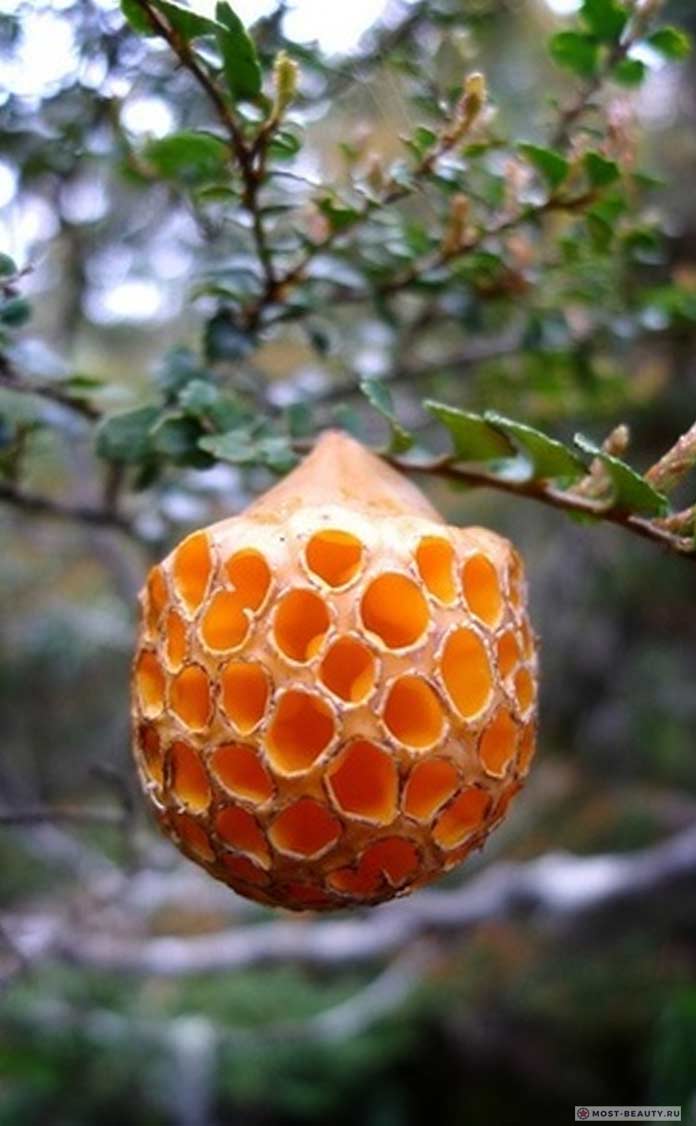
Cyttaria gunnii, commonly known as orange myrtle or beech orange, is an orange-white edible mushroom. It parasitizes trees of the Notofagus Cunningham species native to Australia and Oceania.
They are said to resemble bunches of grapes, with fruiting bodies appearing in clusters in late spring and summer (November to January). Spherical or pear-shaped, they can reach 2.5 cm in diameter. They are covered with a membrane that ruptures, revealing a network of concavities. The aborigines used the fruiting bodies as food. The fruit has a jelly-like consistency and is reported to be palatable.
24
Bleeding Hericium / Hydnellum peckii
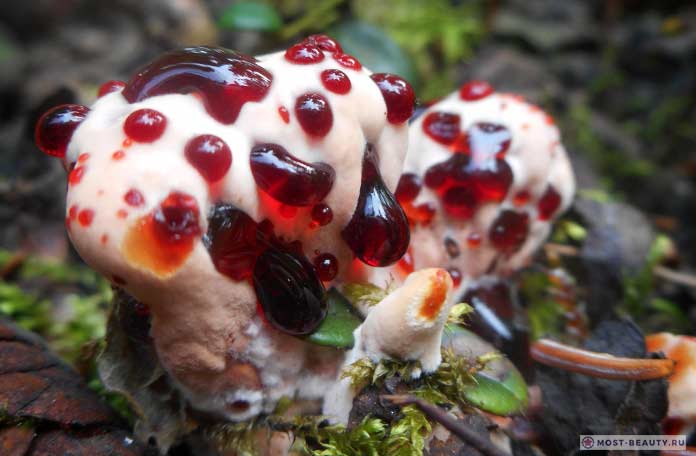
It is difficult to walk past such a handsome man in the forest and not pay attention to him. The Latin name Gidnellum Peka mushroom received in honor of the American mycologist Charles Peck.
But the properties of the fungus to emit a red liquid added to the name of the epithet "bleeding".A fairly common inedible mushroom, which is also romantically called "Strawberry with Cream".
A young mushroom, similar to a bloody tooth, has a white cap with brown holes at the places where red spots are emitted, and over time it completely turns black.
3
Finally

Wikipedia reports that the mushroom world has from 100 to 250 thousand species of mushrooms, and the most daring scientists talk about 1.5 million. Mushrooms are frequent characters in fairy tales and are actively used by animation masters in animation, and decorative mushrooms have long been an adornment of personal plots.
It is also striking that the fungi, isolated in a separate kingdom, have the characteristics of both plants and animal organisms. Maybe that's why picking up mushrooms is called "quiet hunting".

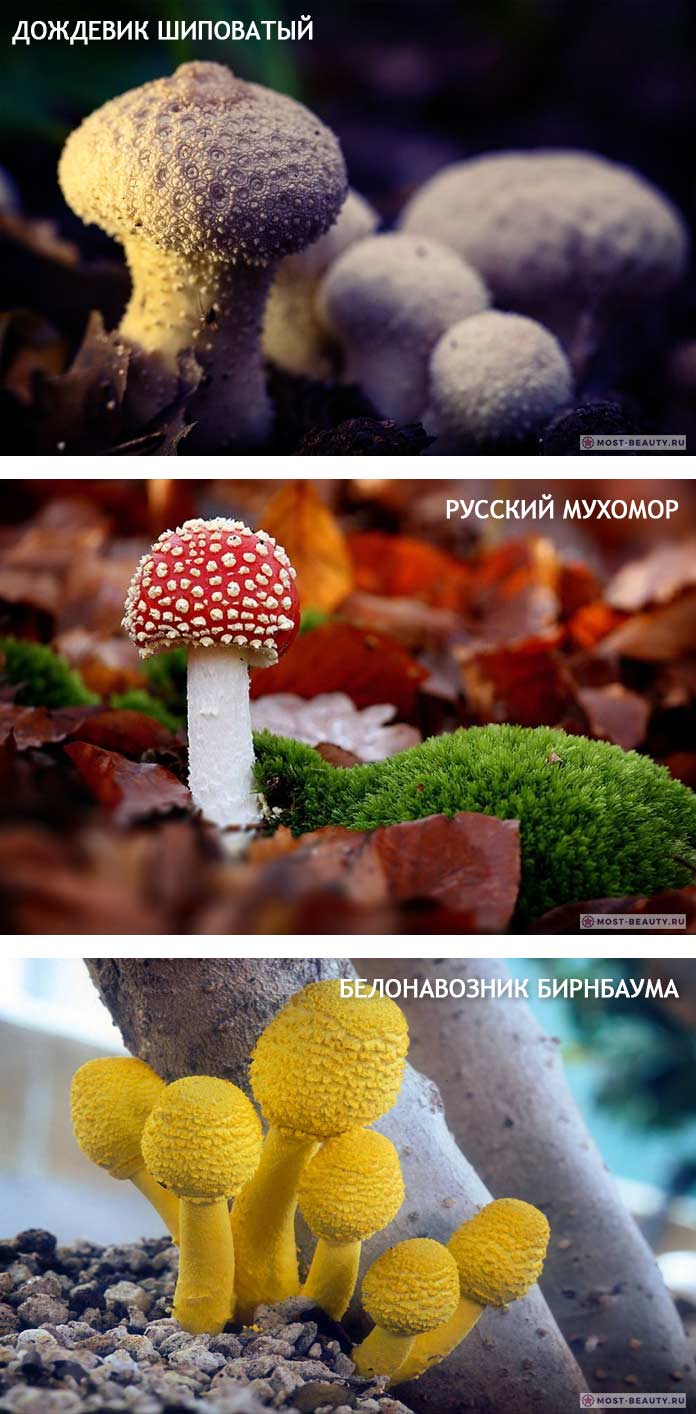
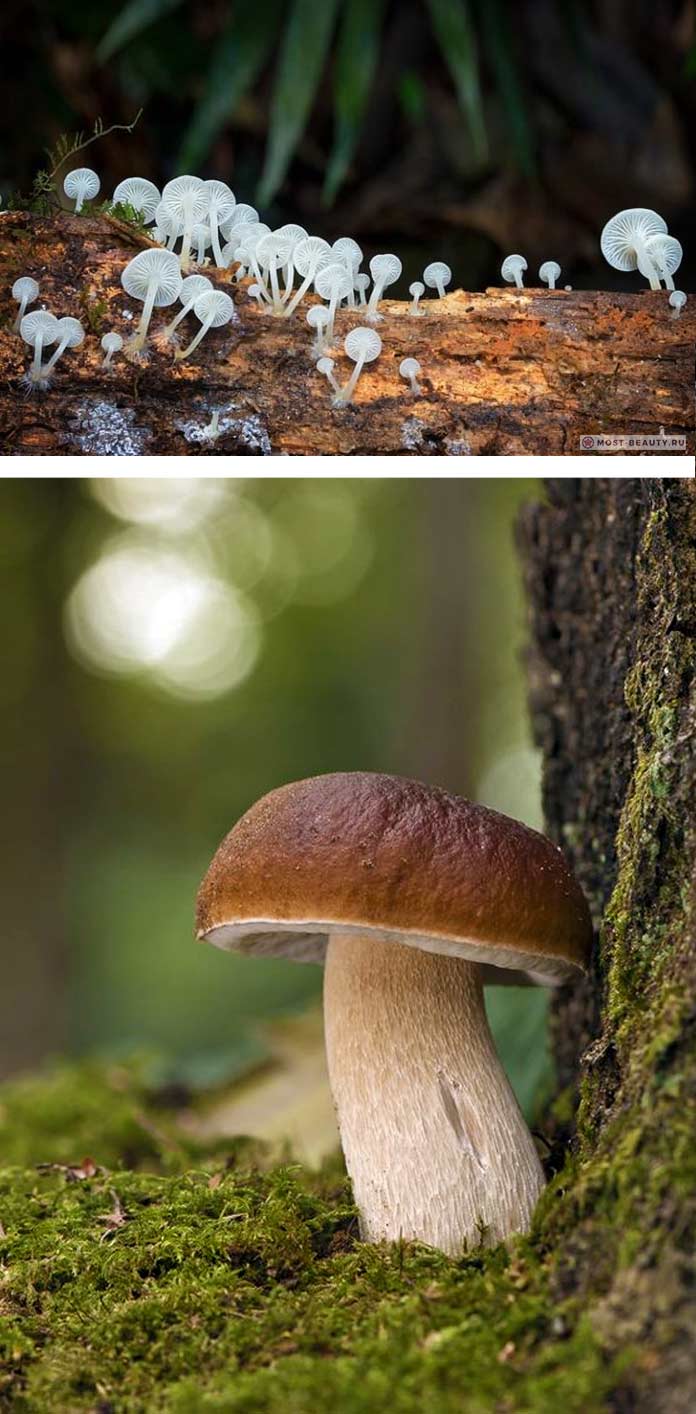
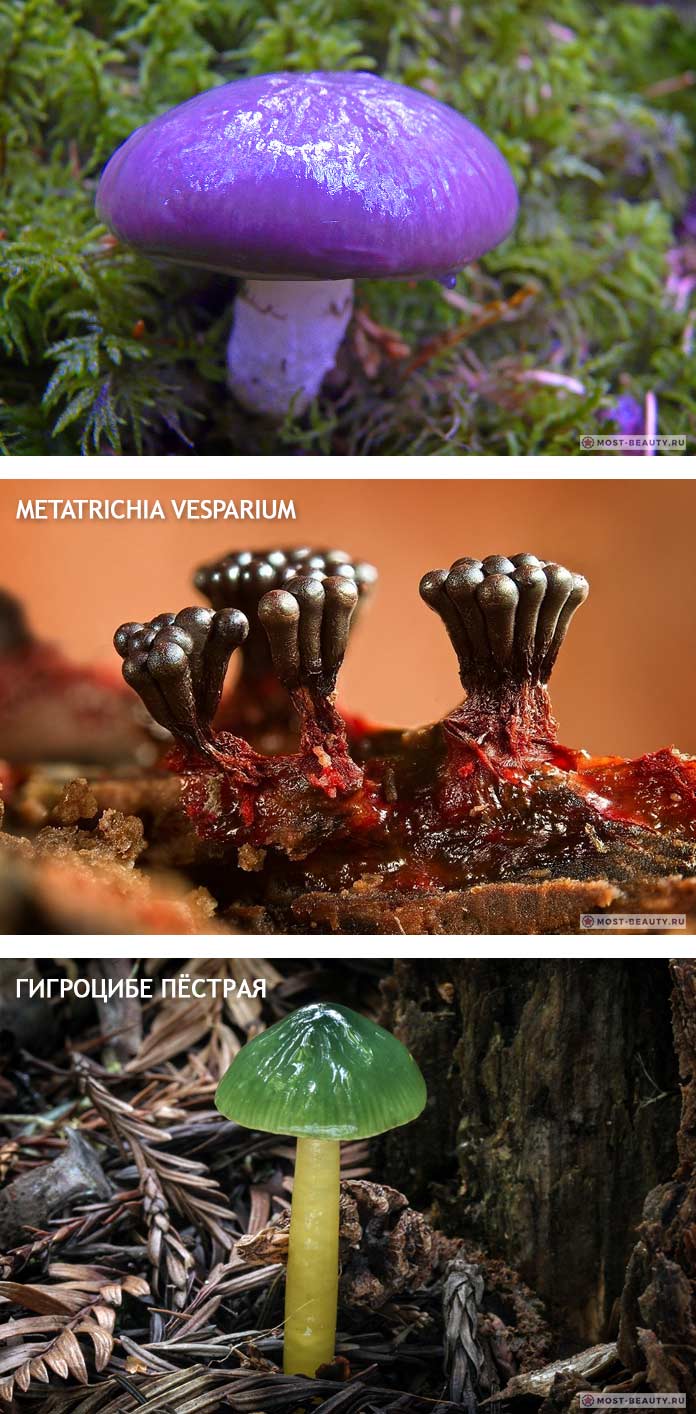
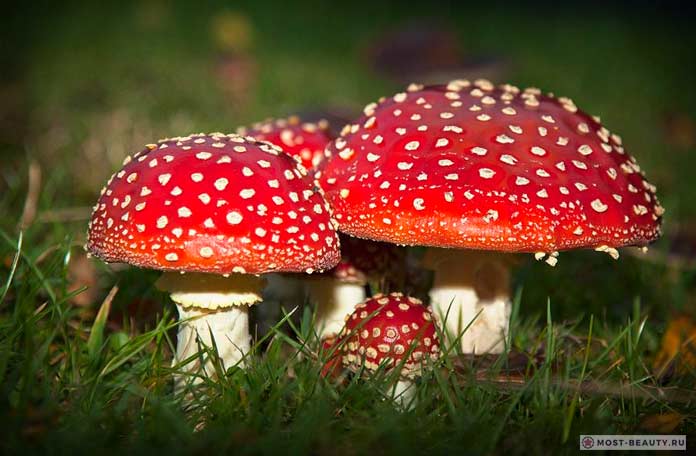

It is simply impossible to stop! I would like to share all the beautiful photos! Continue ...

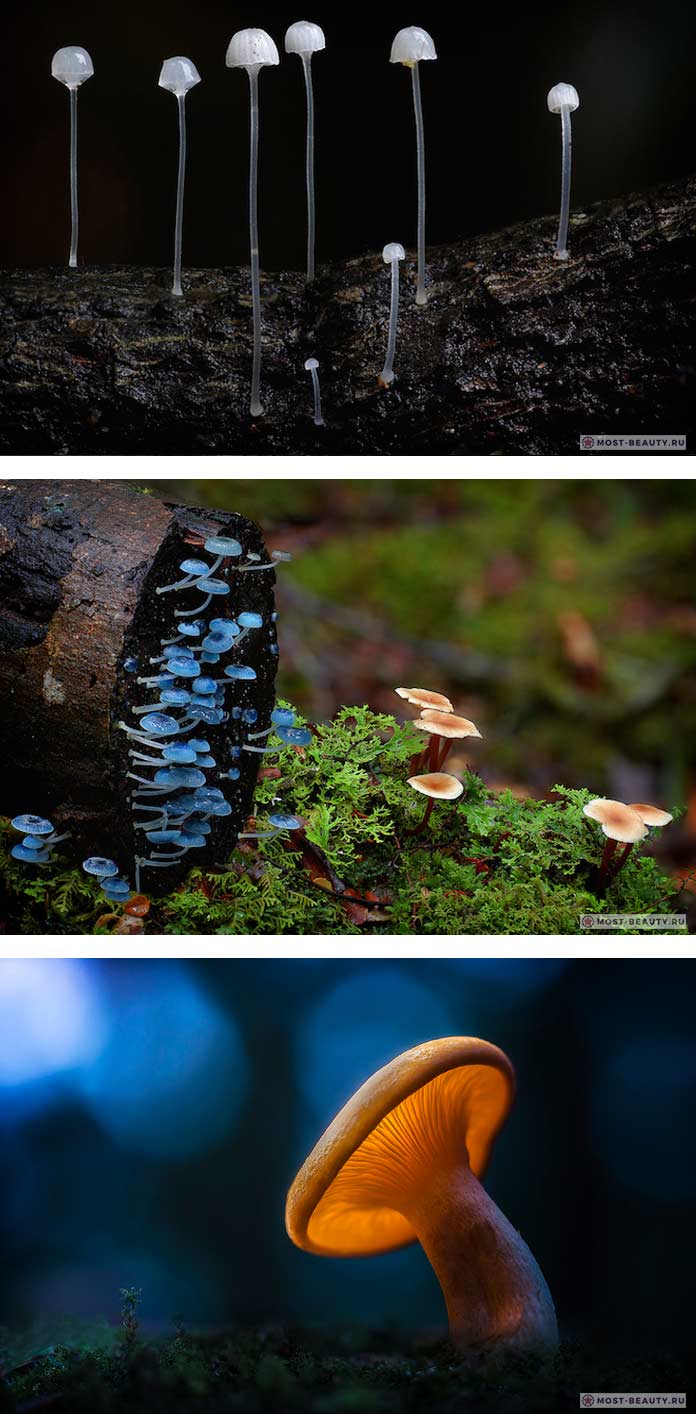
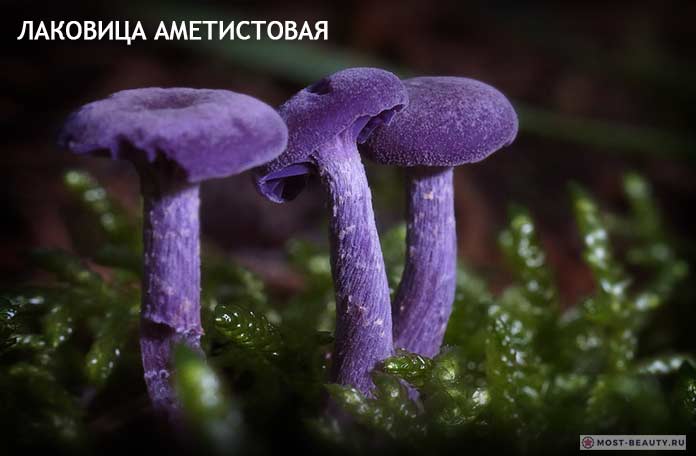
As you can see, the skill and professionalism of photographers greatly influences our perception. Probably, each of us passed by these amazing mushrooms, and failed to see the beauty in them.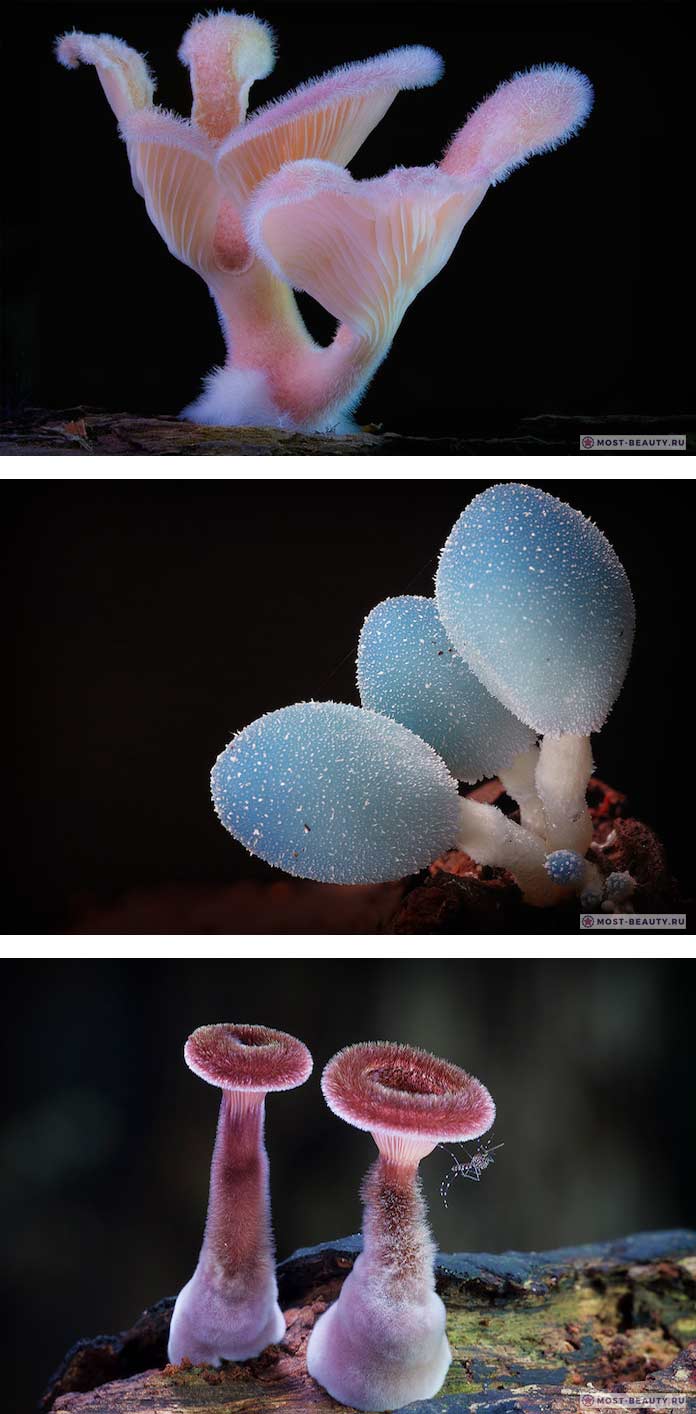
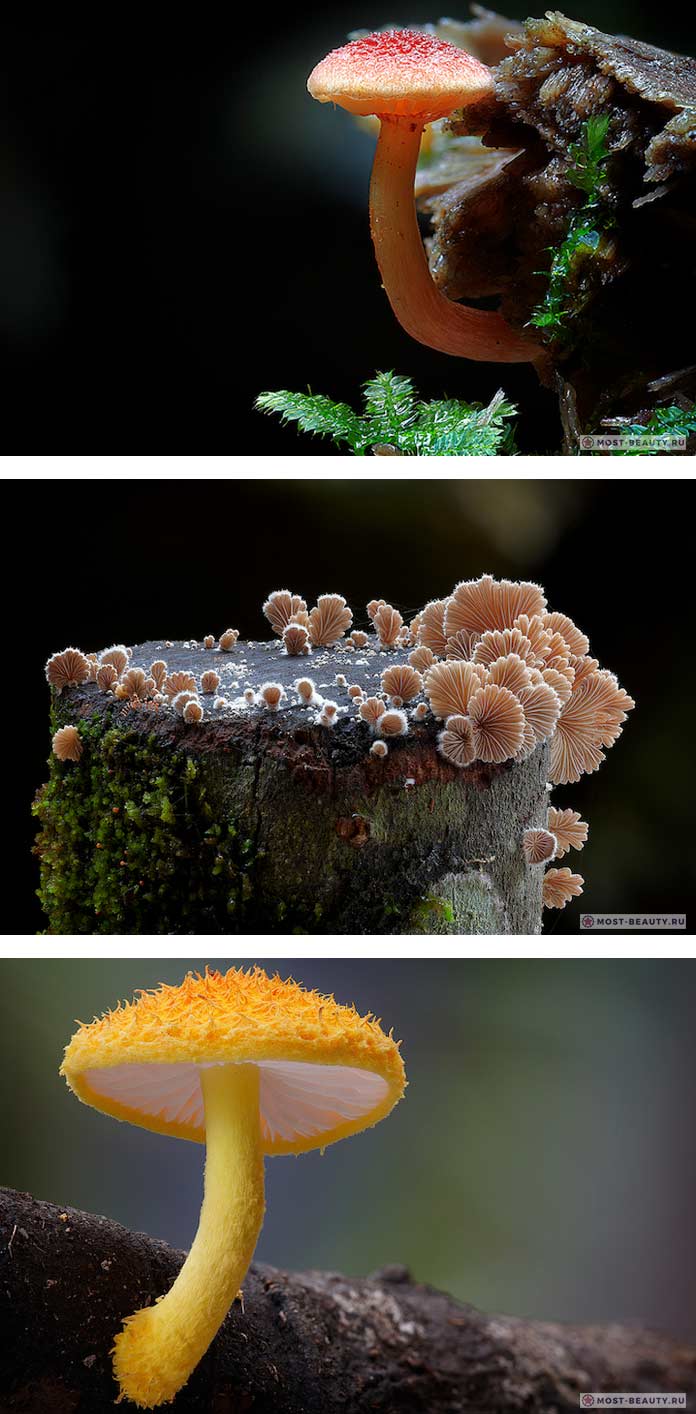

On, and a few more photos, so as not to overload the RAM of your devices!
